-
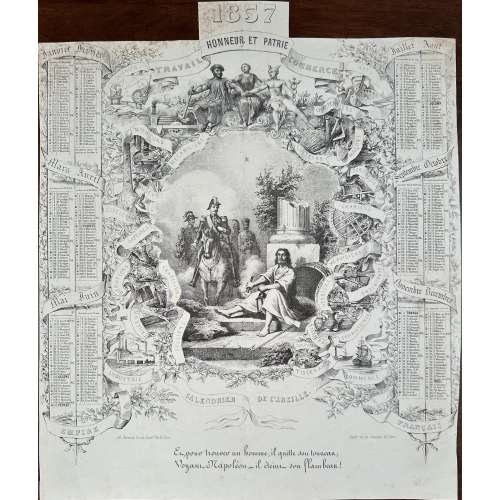 Lithography and etching on wove paper432 x 362 mm, black ink stamp “5022” to reverse, horizontal and vertical centrefolds. Depicts Diogenes (Ancient Greek, 412/404 – 323 BC) beside his barrel and extinguishing his torch when approached by Napoléon III ahorseback. Top: "1857 | HONNEUR ET PATRIE"; lettering on ribbons (top-down): SCIENCES, TRAVAIL, COMMERCE, ARTS, CHARPENTIERS, IMPRIMEURS, "MECHANICIENS, AGRICULTEURS, MAÇONS, FONDEURS, TERRASIERS, CIZELEURS, CARRIERS, ORFEVRES, BIJOUTIERS, CHAPELIERS, MENUISIERS, VERRIERS, SERRURIERS, TAILLEURS, SELLIERS, POTIERS, PORCELAINIERS, CORDONNIERS, TISSERANDS, INDUSTRIE, COMMERCE | CALENDRIER DE L'ABEILLE | EMPIRE, FRANÇAIS. Below left: "lith. Barousse Cour du Comm. 11 et 12. Paris"; right: "Dépôt rue des Cannettes, 20. Paris"; bottom: "Et, pour trouver un homme, il quitte son tonneau, | Voyant Napoléon, – il éteint son flambeau!" [And, to find a man, he leaves his barrel, | Seeing Napoleon, – he extinguishes his torch!]. Six months on the left and six months on the right-hand side of the calendar, surrounding the image.
Lithography and etching on wove paper432 x 362 mm, black ink stamp “5022” to reverse, horizontal and vertical centrefolds. Depicts Diogenes (Ancient Greek, 412/404 – 323 BC) beside his barrel and extinguishing his torch when approached by Napoléon III ahorseback. Top: "1857 | HONNEUR ET PATRIE"; lettering on ribbons (top-down): SCIENCES, TRAVAIL, COMMERCE, ARTS, CHARPENTIERS, IMPRIMEURS, "MECHANICIENS, AGRICULTEURS, MAÇONS, FONDEURS, TERRASIERS, CIZELEURS, CARRIERS, ORFEVRES, BIJOUTIERS, CHAPELIERS, MENUISIERS, VERRIERS, SERRURIERS, TAILLEURS, SELLIERS, POTIERS, PORCELAINIERS, CORDONNIERS, TISSERANDS, INDUSTRIE, COMMERCE | CALENDRIER DE L'ABEILLE | EMPIRE, FRANÇAIS. Below left: "lith. Barousse Cour du Comm. 11 et 12. Paris"; right: "Dépôt rue des Cannettes, 20. Paris"; bottom: "Et, pour trouver un homme, il quitte son tonneau, | Voyant Napoléon, – il éteint son flambeau!" [And, to find a man, he leaves his barrel, | Seeing Napoleon, – he extinguishes his torch!]. Six months on the left and six months on the right-hand side of the calendar, surrounding the image. -
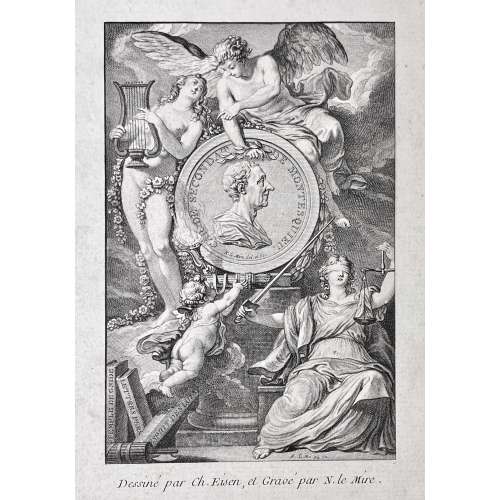 Hardcover volume, 8vo, 24.3 x 16.5 cm, bound in contemporary full marbled calf, spine with raised bands, gilt floral tools in compartments, gilt title lettering, marbled end-papers and all edges, printed on laid paper 23.9 x 5.5 cm with a watermark, entirely engraved (frontispiece, title, nine plates, and text), gatherings not indicated. Title-page (engraved, vignette, tall 's') LE | TEMPLE | DE | GNIDE | Nouvelle Edition, | Avec Figures | Gravées par N. LE MIRE, | des Acad. De Vienne en Autriche et de Rouen, | D’apres les Dessins de Ch. Eisen. | Le Texte Gravé par Droüet. | — | {3 lines quotation from Gallien} | A PARIS | Chez le Mire Graveur | Rue St. Etienne des Gres. | AVEC PRIVELEGE DU ROI. | 1772. || Frontispiece (engraved, vignette): Portrait medallion inscribed "CHARLES SECONDAT DE MONTESQUIEU — N. Le Mire del et sc", signed beneath "N. le Mire sculp 1771"; under the plate: "Dessiné par Ch. Eisen, et Gravé par N. le Mire." Pagination: frontispiece, t.p. / explication, dedication, [i] ii-vii [viii blank] 1-104 [105-6 blanks]; engraved throughout, plus 9 plates by Le Mire after Eisen.Catalogue Raisonné: Cohen-de Ricci 726-27; Ray, French Illustrated Book, №32/p. 61-2.Ref.: MFA (Boston): Accession Number 37.1726.Charles Eisen (French, 1720 – 1778) – artist. Noël Le Mire (French, 1724 – 1801) – engraver, publisher. Droüet (French, 18th century) – text engraver. Charles Louis de Secondat, Baron de La Brède et de Montesquieu (French, 1689 – 1755) – author.
Hardcover volume, 8vo, 24.3 x 16.5 cm, bound in contemporary full marbled calf, spine with raised bands, gilt floral tools in compartments, gilt title lettering, marbled end-papers and all edges, printed on laid paper 23.9 x 5.5 cm with a watermark, entirely engraved (frontispiece, title, nine plates, and text), gatherings not indicated. Title-page (engraved, vignette, tall 's') LE | TEMPLE | DE | GNIDE | Nouvelle Edition, | Avec Figures | Gravées par N. LE MIRE, | des Acad. De Vienne en Autriche et de Rouen, | D’apres les Dessins de Ch. Eisen. | Le Texte Gravé par Droüet. | — | {3 lines quotation from Gallien} | A PARIS | Chez le Mire Graveur | Rue St. Etienne des Gres. | AVEC PRIVELEGE DU ROI. | 1772. || Frontispiece (engraved, vignette): Portrait medallion inscribed "CHARLES SECONDAT DE MONTESQUIEU — N. Le Mire del et sc", signed beneath "N. le Mire sculp 1771"; under the plate: "Dessiné par Ch. Eisen, et Gravé par N. le Mire." Pagination: frontispiece, t.p. / explication, dedication, [i] ii-vii [viii blank] 1-104 [105-6 blanks]; engraved throughout, plus 9 plates by Le Mire after Eisen.Catalogue Raisonné: Cohen-de Ricci 726-27; Ray, French Illustrated Book, №32/p. 61-2.Ref.: MFA (Boston): Accession Number 37.1726.Charles Eisen (French, 1720 – 1778) – artist. Noël Le Mire (French, 1724 – 1801) – engraver, publisher. Droüet (French, 18th century) – text engraver. Charles Louis de Secondat, Baron de La Brède et de Montesquieu (French, 1689 – 1755) – author. -
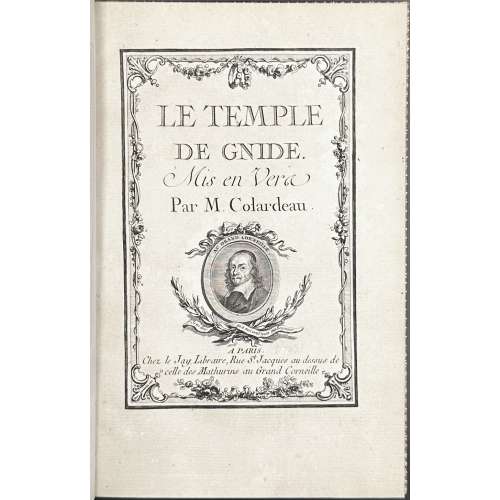 Hardcover volume, 8vo, 21.5 x 14.5 cm, bound by Riviere & Son (stamped on fep verso bottom) in full brown calf, boards with triple gilt fillet border and gilt dentelle inside, spine with raised bands, gilt in compartments, black label with gilt lettering, all margins gilt, blue endpapers, bookplate of Arthur Rau pasted to front pastedown (text: Les hommes sont méchants mais leurs livres sont bons / Arthur Rau; signed: E. H. New – A.D. 1922), traces of removed owner’s label to fep recto; printed on laid paper. Title-page (engraved, in floral frame): LE TEMPLE | DE GNIDE. | Mis en Vers | Par M. Colardeau | {vignette with portrait of Pierre Corneille} | A PARIS | Chez le Jay, Libraire, Rue St. Jacques au dessus de | celle des Mathurins au Grand Corneille || Collation: 2 blanks, h.t., engraved t.p. with a portrait of Pierre Corneille, a8, A-E8 F4 (52 leaves), 2 blanks, plus 7 plates by various engravers after Charles Monnet. Pagination: [i] ii-xvi, [1] 2-88 (104 pp). Ref: MFA (Boston): accession number 37.1747 Catalogue raisonné: Lewine 114, Cohen-DeRicci 245-6. Contributors: Charles Monnet (French, 1732 – after 1808) – artist. Engravers: Jean Charles Baquoy (French, 1721 – 1777) Nicolas Delaunay (French, 1739 – 1792) Isidore Stanislas Helman (French, 1743 – 1806) Louis Joseph Masquelier (French, 1741 – 1811) François Denis Née (French, 1735 – 1818) Nicholas Ponce (French, 1746 – 1831) Portrait(s) designed by: Guillaume Voiriot (French, 1713 – 1799) Author: Charles-Pierre Colardeau (French, 1732 – 1776) Publisher: Edmé-Jean Le Jay (French, 1734 – 1795) Bookplate artist: Edmund Hort New (British, 1871 – 1931) Provenance: Arthur Rau (British, 1898 – 1972); his obituary can be found in The Book Collector 1973, vol. 22, n°1, p. 86-89. According to the genealogy service Geni, Arthur Aron Rau was born to Jacob Aryeh Rau and Katharina (Kaethe) Rau, and has a sister Cecilia (Tsipporah) Rosenfelder and a brother Frederick Solomon Rau. He went to Oxford and then joined Maggs Brothers in their Paris establishment. "After some years there, he set up on his own, returning to England at the outbreak of the Second World War to be a schoolmaster for ten years". In 1949 he returned to Paris and retired in 1963, "and his last years he happily spent in Wensleydale...". All he published during his lifetime were two catalogues, Livres Rares Et Anciens. Manuscrits et Autographes. — Paris: Arthur Rau, 1932-3 and Cinquante Tres Beaux Livres Avec Un Appendice. — Paris: Arthur Rau, 1933. He also contributed to The Book Collector.Seller’s description: In-8° : [2]-t. gr.-xvi-88 pp. ; 7 h.-t. (qqs rouss.). - Poème d'après le roman de Montesquieu ill. de 7 eaux-fortes par Bacquoy, Delaunay, Née, etc., d'après Charles Monnet. Titre gr. orné d'un portr. de Corneille. Cohen, qui cite un ex. millésimé 1773, signale des ex. avec la date de 1772 ou sans date. - Réf. Cohen 245-246. - Conlon 72:675 (éd. à l'adresse d'Amsterdam et Paris, 1772). - Pas dans Reynaud. - Prov. Arthur Rau (1898-1972), gérant de la librairie Maggs à Paris avant d'ouvrir sa propre librairie en 1932 (ex-libris gr. par E.H. New, 1922 ; réf. BnF). - Traces d'ex-libris décollé à la garde sup.
Hardcover volume, 8vo, 21.5 x 14.5 cm, bound by Riviere & Son (stamped on fep verso bottom) in full brown calf, boards with triple gilt fillet border and gilt dentelle inside, spine with raised bands, gilt in compartments, black label with gilt lettering, all margins gilt, blue endpapers, bookplate of Arthur Rau pasted to front pastedown (text: Les hommes sont méchants mais leurs livres sont bons / Arthur Rau; signed: E. H. New – A.D. 1922), traces of removed owner’s label to fep recto; printed on laid paper. Title-page (engraved, in floral frame): LE TEMPLE | DE GNIDE. | Mis en Vers | Par M. Colardeau | {vignette with portrait of Pierre Corneille} | A PARIS | Chez le Jay, Libraire, Rue St. Jacques au dessus de | celle des Mathurins au Grand Corneille || Collation: 2 blanks, h.t., engraved t.p. with a portrait of Pierre Corneille, a8, A-E8 F4 (52 leaves), 2 blanks, plus 7 plates by various engravers after Charles Monnet. Pagination: [i] ii-xvi, [1] 2-88 (104 pp). Ref: MFA (Boston): accession number 37.1747 Catalogue raisonné: Lewine 114, Cohen-DeRicci 245-6. Contributors: Charles Monnet (French, 1732 – after 1808) – artist. Engravers: Jean Charles Baquoy (French, 1721 – 1777) Nicolas Delaunay (French, 1739 – 1792) Isidore Stanislas Helman (French, 1743 – 1806) Louis Joseph Masquelier (French, 1741 – 1811) François Denis Née (French, 1735 – 1818) Nicholas Ponce (French, 1746 – 1831) Portrait(s) designed by: Guillaume Voiriot (French, 1713 – 1799) Author: Charles-Pierre Colardeau (French, 1732 – 1776) Publisher: Edmé-Jean Le Jay (French, 1734 – 1795) Bookplate artist: Edmund Hort New (British, 1871 – 1931) Provenance: Arthur Rau (British, 1898 – 1972); his obituary can be found in The Book Collector 1973, vol. 22, n°1, p. 86-89. According to the genealogy service Geni, Arthur Aron Rau was born to Jacob Aryeh Rau and Katharina (Kaethe) Rau, and has a sister Cecilia (Tsipporah) Rosenfelder and a brother Frederick Solomon Rau. He went to Oxford and then joined Maggs Brothers in their Paris establishment. "After some years there, he set up on his own, returning to England at the outbreak of the Second World War to be a schoolmaster for ten years". In 1949 he returned to Paris and retired in 1963, "and his last years he happily spent in Wensleydale...". All he published during his lifetime were two catalogues, Livres Rares Et Anciens. Manuscrits et Autographes. — Paris: Arthur Rau, 1932-3 and Cinquante Tres Beaux Livres Avec Un Appendice. — Paris: Arthur Rau, 1933. He also contributed to The Book Collector.Seller’s description: In-8° : [2]-t. gr.-xvi-88 pp. ; 7 h.-t. (qqs rouss.). - Poème d'après le roman de Montesquieu ill. de 7 eaux-fortes par Bacquoy, Delaunay, Née, etc., d'après Charles Monnet. Titre gr. orné d'un portr. de Corneille. Cohen, qui cite un ex. millésimé 1773, signale des ex. avec la date de 1772 ou sans date. - Réf. Cohen 245-246. - Conlon 72:675 (éd. à l'adresse d'Amsterdam et Paris, 1772). - Pas dans Reynaud. - Prov. Arthur Rau (1898-1972), gérant de la librairie Maggs à Paris avant d'ouvrir sa propre librairie en 1932 (ex-libris gr. par E.H. New, 1922 ; réf. BnF). - Traces d'ex-libris décollé à la garde sup. -
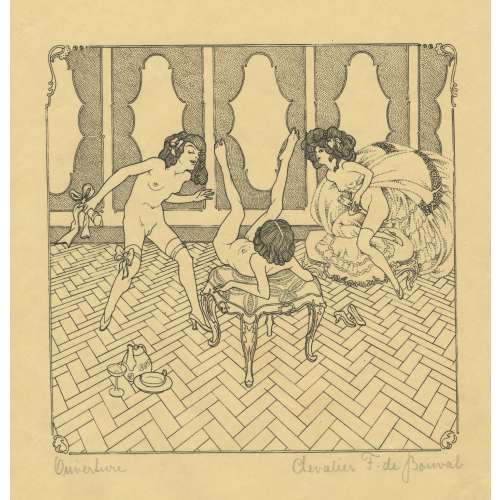 A set of sixteen planographic prints, signed and titled in pencil by owner “Chevalier F. de Bouval” (pseudonym of Franz von Bayros (Austrian, 1866 – 1924). Titles include: 1) Ouverture, 2) champagne brut, 3) maternité, 4) piano, 5) crudité délicieuse, 6. la belle vue, 7) au pensionnat, 8) le collier, 9) languelles pénètrelles, 10) introduction, 11) le sourrogat, 12) variation amoureuse, 13) la surprise, 14) le clef délicat, 15) le monstre gomme, 16) fruits de sud. Printed on wove paper, possibly engraved on wood after ink drawings by Franz von Bayros (Austrian, 1866 – 1924) under the pseudonym Chevalier F. de Bouval. Size: sheet 30 x 24 cm, image 18 x 17.5 cm. In another source, there are two more images from the same set: le passe-partout and la doublette, making 18 images altogether; the set is titled “Lesbia: XVIII sujets”, signed by Chevalier François René de Bouval.
A set of sixteen planographic prints, signed and titled in pencil by owner “Chevalier F. de Bouval” (pseudonym of Franz von Bayros (Austrian, 1866 – 1924). Titles include: 1) Ouverture, 2) champagne brut, 3) maternité, 4) piano, 5) crudité délicieuse, 6. la belle vue, 7) au pensionnat, 8) le collier, 9) languelles pénètrelles, 10) introduction, 11) le sourrogat, 12) variation amoureuse, 13) la surprise, 14) le clef délicat, 15) le monstre gomme, 16) fruits de sud. Printed on wove paper, possibly engraved on wood after ink drawings by Franz von Bayros (Austrian, 1866 – 1924) under the pseudonym Chevalier F. de Bouval. Size: sheet 30 x 24 cm, image 18 x 17.5 cm. In another source, there are two more images from the same set: le passe-partout and la doublette, making 18 images altogether; the set is titled “Lesbia: XVIII sujets”, signed by Chevalier François René de Bouval. -
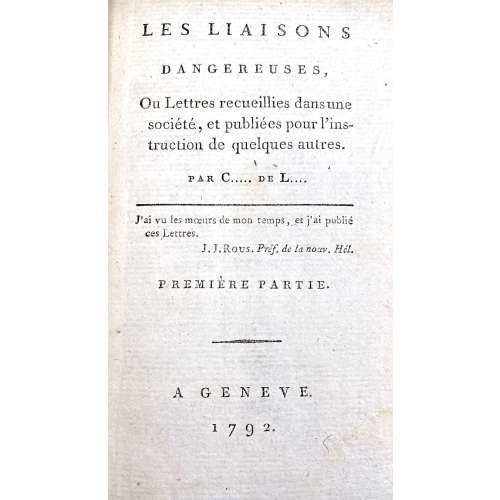 Four parts bound in two 18mo volumes (1-2 & 3-4), half polished brown calf, dot-ruled, flat spine with gilt bands and lettering, marbled boards, some plates with guard sheets, margins sparkled red. Title-page: LES LIAISONS | DANGEREUSES, | Ou Lettres recueillies dans une | société, et publiées pour l’ins- | truction de quelques autres. | par C….. de L… | — | J’ai vu les mœurs de mon temps, et j’ai publié | ces Lettres. | J. J. Rous. Préf. De la nouv. Hél. | PREMIÈRE PARTIE. | — | A GENEVE. | 1792. || Vol. 1: Pagination: ffep, blank, [2] – h.t., [i, ii] – t.p. part one, [iii] iv-xxij, [1] 2-245 [246] + 2 plates (p. 26 & p. 75); [1, 2] – h.t., [3, 4] – t.p. part two, [5] 6-233 [234], fep + 2 plates (p. 59 & p. 222). Collation: part 1: a12, A-M18 N5; part 2: A-M18 N9, plus four plates by various engravers after Le Barbier. Vol. 2: Pagination: ffep, blank, [1, 2] – h.t., [3, 4] – t.p. part three, [5] 6-225 [226] + 2 plates (p. 69 & p. 215); [1, 2] – h.t., [3, 4] – t.p. part four, [5] 6-250, fep + 2 plates (p. 25 & p. 201). Collation: part 3: A-M18 N5; part 4: A-N18 O5, plus four plates by various engravers after Le Barbier. Illustrations: After Le Barbier, engravers: Halbou (1), Simonet (1), N. Thomas (2), Dambrun (2), and Delignon (2). In the first illustration (vol. 1, part one, p. 26) Le Barbier signed “Le Barbier Jnv. 1794”, however, the edition was published (anonymously) in 1792. Cohen-De Ricci mentions an edition of 1794 (Paris: Maradan) and 1801 (Genéve) with the same plates. Lewine mentions a reprint of 1794 without naming the publisher. Catalogue raisonné: Cohen-De Ricci: 234-5, Ray: p. 79; Lewine: 109-10. Contributors: Choderlos de Laclos, Pierre Ambroise François (French, 1741 – 1803) – author. Le Barbier, Jean-Jacques-François (French, 1738 – 1826) – artist Engravers: Dambrun, Jean (French, 1741 – c. 1808) Delignon, Jean Louis (French, 1755 – 1804) Halbou, Louis Michel (1730 – 1809) Thomas, N. (French, c. 1750 – 1812) Simonet, Jean-Baptiste Blaise (French, 1742 – 1813)
Four parts bound in two 18mo volumes (1-2 & 3-4), half polished brown calf, dot-ruled, flat spine with gilt bands and lettering, marbled boards, some plates with guard sheets, margins sparkled red. Title-page: LES LIAISONS | DANGEREUSES, | Ou Lettres recueillies dans une | société, et publiées pour l’ins- | truction de quelques autres. | par C….. de L… | — | J’ai vu les mœurs de mon temps, et j’ai publié | ces Lettres. | J. J. Rous. Préf. De la nouv. Hél. | PREMIÈRE PARTIE. | — | A GENEVE. | 1792. || Vol. 1: Pagination: ffep, blank, [2] – h.t., [i, ii] – t.p. part one, [iii] iv-xxij, [1] 2-245 [246] + 2 plates (p. 26 & p. 75); [1, 2] – h.t., [3, 4] – t.p. part two, [5] 6-233 [234], fep + 2 plates (p. 59 & p. 222). Collation: part 1: a12, A-M18 N5; part 2: A-M18 N9, plus four plates by various engravers after Le Barbier. Vol. 2: Pagination: ffep, blank, [1, 2] – h.t., [3, 4] – t.p. part three, [5] 6-225 [226] + 2 plates (p. 69 & p. 215); [1, 2] – h.t., [3, 4] – t.p. part four, [5] 6-250, fep + 2 plates (p. 25 & p. 201). Collation: part 3: A-M18 N5; part 4: A-N18 O5, plus four plates by various engravers after Le Barbier. Illustrations: After Le Barbier, engravers: Halbou (1), Simonet (1), N. Thomas (2), Dambrun (2), and Delignon (2). In the first illustration (vol. 1, part one, p. 26) Le Barbier signed “Le Barbier Jnv. 1794”, however, the edition was published (anonymously) in 1792. Cohen-De Ricci mentions an edition of 1794 (Paris: Maradan) and 1801 (Genéve) with the same plates. Lewine mentions a reprint of 1794 without naming the publisher. Catalogue raisonné: Cohen-De Ricci: 234-5, Ray: p. 79; Lewine: 109-10. Contributors: Choderlos de Laclos, Pierre Ambroise François (French, 1741 – 1803) – author. Le Barbier, Jean-Jacques-François (French, 1738 – 1826) – artist Engravers: Dambrun, Jean (French, 1741 – c. 1808) Delignon, Jean Louis (French, 1755 – 1804) Halbou, Louis Michel (1730 – 1809) Thomas, N. (French, c. 1750 – 1812) Simonet, Jean-Baptiste Blaise (French, 1742 – 1813) -
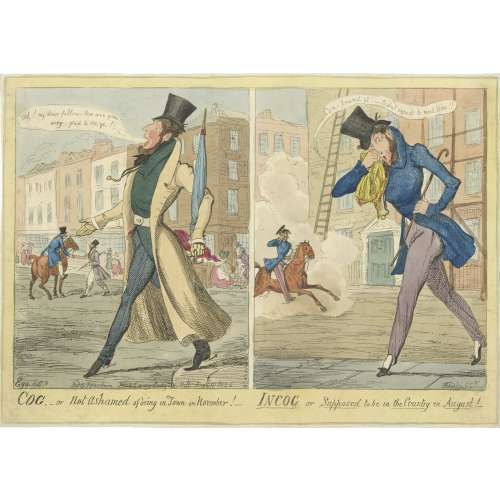 Description by British Museum (1865,1111.2128): "Two designs, side by side. [1] A dandy (probably a portrait), florid, whiskered, and bearded, steps jauntily from the pavement, hand extended, saying: Ah! my dear fellow — How are you? Devilish glad to see ye!— He holds a closed umbrella, ferrule erect, and wears a long tight-waisted coat to the heels, unbuttoned, tight pantaloons and spurred boots. In the middle distance, another dandy grasps the hand of a friend on horseback. Behind are houses with shop-fronts. A man raises his hat to a lady who curtseys. [2] The same dandy steps from the roadway onto the pavement, his handkerchief to his nose; he stoops, trying to conceal himself from a dandy cantering past in a cloud of dust, his eye-glass to his eye. He is without gloves, extraordinary for a dandy, and his trousers are strapped over pumps; he says: Con-found it! — Didn't expect to meet Him!! The street is otherwise empty; against the (large) houses are scaffolding and a tall ladder." Lettered with title, text within image including production details: 'Ego. delt / Etched by G. Ck / Pubd by J Fairburn Broadway Ludgate Hill August 18 1826'. Dimensions: Sheet: 25.5 x 36 cm, Image: 21.7 x 33.8 cm. Catalogue raisonné: A. M. Cohn (1924): № 1001, p. 262.: "A wretched plate. Difficult to believe G. C. had anything to do with it." — Bruton. Value.— £1.
Description by British Museum (1865,1111.2128): "Two designs, side by side. [1] A dandy (probably a portrait), florid, whiskered, and bearded, steps jauntily from the pavement, hand extended, saying: Ah! my dear fellow — How are you? Devilish glad to see ye!— He holds a closed umbrella, ferrule erect, and wears a long tight-waisted coat to the heels, unbuttoned, tight pantaloons and spurred boots. In the middle distance, another dandy grasps the hand of a friend on horseback. Behind are houses with shop-fronts. A man raises his hat to a lady who curtseys. [2] The same dandy steps from the roadway onto the pavement, his handkerchief to his nose; he stoops, trying to conceal himself from a dandy cantering past in a cloud of dust, his eye-glass to his eye. He is without gloves, extraordinary for a dandy, and his trousers are strapped over pumps; he says: Con-found it! — Didn't expect to meet Him!! The street is otherwise empty; against the (large) houses are scaffolding and a tall ladder." Lettered with title, text within image including production details: 'Ego. delt / Etched by G. Ck / Pubd by J Fairburn Broadway Ludgate Hill August 18 1826'. Dimensions: Sheet: 25.5 x 36 cm, Image: 21.7 x 33.8 cm. Catalogue raisonné: A. M. Cohn (1924): № 1001, p. 262.: "A wretched plate. Difficult to believe G. C. had anything to do with it." — Bruton. Value.— £1. -
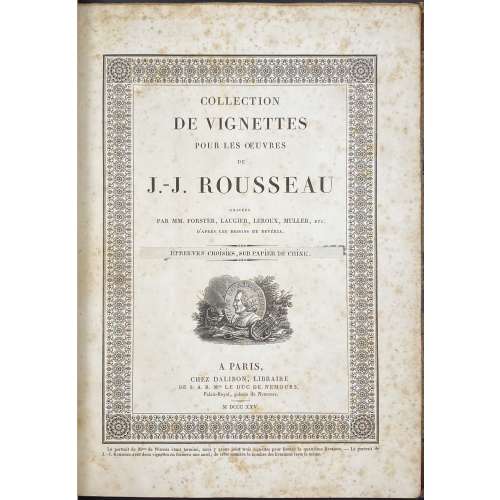 Pictorial album of 41 etchings, incl. two portraits, by various engravers after Achille Devéria, printed on India paper (after letters) and pasted on thick wove paper, bound with tissue guards in half calf over marbled boards bordered gilt, spine decorated gilt, marbled endpapers; base paper and tissue guards are substantially foxed, images mostly intact. The title page and the subscription page are bound-in at the beginning and at the end, respectively. Title page: (in ornamental frame): COLLECTION | DE VIGNETTES | POUR LES ŒUVRES | DE | J.-J. ROUSSEAU | GRAVÉES | PAR MM. FORSTER, LAUGIER, LEROUX, MULLER, ETC. | D'APRÈS LES DESSINS DE DEVÉRIA. | (pasted over) ÉPREUVES CHOISIES, SUR PAPIER DE CHINE. | {publisher’s device} | A PARIS, | CHEZ DALIBON, LIBRAIRE | DE S. A. R. MGR LE DUC DE NEMOURS, | Palais-Royal, galerie de Nemours. | M DCCC XXV. | Under the frame: Le portrait de Mme de Warens étant terminé, nous y avons joint trois vignettes pour former la quatrième livraison. — Le portrait de | J.-J. Rousseau avec deux vignettes en formera une aussi ; de cette manière le nombre des livraisons reste le même. || This collection was published by Dalibon the same year as the 25-volume Rousseau's Œuvres completes. Related persons: Jean-Jacques Rousseau (French, 1712 – 1778). Mme de Warens: Françoise-Louise de Warens [Louise Éléonore de la Tour du Pil] Swiss, 1699 – 1762). S.A.R. Mgr Le Duc de Nemours: Prince Louis of Orléans, Duke of Nemours [Louis Charles Philippe Raphaël d'Orléans] (French, 1814 – 1896). Contributors: François-Denis Dalibon (French, 1794 – 1853) – publisher. L'Imprimerie de Rignoux (Paris); Thomas-François Rignoux (1781 – 1863?) – printer. Achille Devéria (French, 1800 – 1857) – artist. Engravers : François Forster (French, 1790 – 1872) Jean Nicolas Laugier (French, 1785 – 1875) Jean Marie Leroux (French, 1788 – 1871) Henri Charles Müller (French, 1784 – 1845) Herbert König (German, 1820 – 1876) Louis Jean Désiré Delaistre (French, 1800 – 1871) Jean Louis Toussaint Caron (French, 1790 – 1832) Pierre Michel Adam (French, 1799 – 1853) Ferdinand Sébastien Goulu (French, 1796 – 1848) Jean-François Pourvoyeur (French, 1784 – 1851) Jean Baptiste Touzé (French, fl. 1810 – 1830) Narcisse Lecomte (French, 1794 – 1882) Louis Hercule Sisco (French, 1778 – 1861) Edme Jean Ruhierre (French, 1789 – fl. 1826) Auguste Thomas Marie Blanchard (French, 1819 – 1898) François Manceau (French, 1768 – after 1837) Gabriel Louis Lacour-Lestudier (French, 1800 – 1849) Fulley [Frilley?] Jean Jacques Frilley (French, 1797 – after 1850) Philippe Joseph Augustin Vallot (French, 1796 – 1870) Etienne Devilliers (French, 1784 – after 1844) Jean Bosq (French, fl. c. 1801 – 1844) Zachée Prévost (French, 1797 – 1861) Jean Baptiste Guyard II (French, 1787 – 1831/32) Antoine François Gelée (French, 1796-1860) Constant Louis Antoine Lorichon (French, 1800-1856?) Antoine Joseph Chollet (French, 1793 – after 1848) Adrien Migneret (French, 1786 – 1840) Alfred Johannot (French, 1800 – 1837) Arnold Jéhotte (French, 1789 – 1836) Hippolyte Prudhomme (French, 1793 – 1853) Achille Lefèvre (French, 1798 – 1864) Pierre Pelée (French, 1801 – 1871) Antoine [Tony] Johannot (French, 1803 – 1852) Pierre Joseph Tavernier (French, 1787 – after 1845) Leclerc (?) Levasseur (?)
Pictorial album of 41 etchings, incl. two portraits, by various engravers after Achille Devéria, printed on India paper (after letters) and pasted on thick wove paper, bound with tissue guards in half calf over marbled boards bordered gilt, spine decorated gilt, marbled endpapers; base paper and tissue guards are substantially foxed, images mostly intact. The title page and the subscription page are bound-in at the beginning and at the end, respectively. Title page: (in ornamental frame): COLLECTION | DE VIGNETTES | POUR LES ŒUVRES | DE | J.-J. ROUSSEAU | GRAVÉES | PAR MM. FORSTER, LAUGIER, LEROUX, MULLER, ETC. | D'APRÈS LES DESSINS DE DEVÉRIA. | (pasted over) ÉPREUVES CHOISIES, SUR PAPIER DE CHINE. | {publisher’s device} | A PARIS, | CHEZ DALIBON, LIBRAIRE | DE S. A. R. MGR LE DUC DE NEMOURS, | Palais-Royal, galerie de Nemours. | M DCCC XXV. | Under the frame: Le portrait de Mme de Warens étant terminé, nous y avons joint trois vignettes pour former la quatrième livraison. — Le portrait de | J.-J. Rousseau avec deux vignettes en formera une aussi ; de cette manière le nombre des livraisons reste le même. || This collection was published by Dalibon the same year as the 25-volume Rousseau's Œuvres completes. Related persons: Jean-Jacques Rousseau (French, 1712 – 1778). Mme de Warens: Françoise-Louise de Warens [Louise Éléonore de la Tour du Pil] Swiss, 1699 – 1762). S.A.R. Mgr Le Duc de Nemours: Prince Louis of Orléans, Duke of Nemours [Louis Charles Philippe Raphaël d'Orléans] (French, 1814 – 1896). Contributors: François-Denis Dalibon (French, 1794 – 1853) – publisher. L'Imprimerie de Rignoux (Paris); Thomas-François Rignoux (1781 – 1863?) – printer. Achille Devéria (French, 1800 – 1857) – artist. Engravers : François Forster (French, 1790 – 1872) Jean Nicolas Laugier (French, 1785 – 1875) Jean Marie Leroux (French, 1788 – 1871) Henri Charles Müller (French, 1784 – 1845) Herbert König (German, 1820 – 1876) Louis Jean Désiré Delaistre (French, 1800 – 1871) Jean Louis Toussaint Caron (French, 1790 – 1832) Pierre Michel Adam (French, 1799 – 1853) Ferdinand Sébastien Goulu (French, 1796 – 1848) Jean-François Pourvoyeur (French, 1784 – 1851) Jean Baptiste Touzé (French, fl. 1810 – 1830) Narcisse Lecomte (French, 1794 – 1882) Louis Hercule Sisco (French, 1778 – 1861) Edme Jean Ruhierre (French, 1789 – fl. 1826) Auguste Thomas Marie Blanchard (French, 1819 – 1898) François Manceau (French, 1768 – after 1837) Gabriel Louis Lacour-Lestudier (French, 1800 – 1849) Fulley [Frilley?] Jean Jacques Frilley (French, 1797 – after 1850) Philippe Joseph Augustin Vallot (French, 1796 – 1870) Etienne Devilliers (French, 1784 – after 1844) Jean Bosq (French, fl. c. 1801 – 1844) Zachée Prévost (French, 1797 – 1861) Jean Baptiste Guyard II (French, 1787 – 1831/32) Antoine François Gelée (French, 1796-1860) Constant Louis Antoine Lorichon (French, 1800-1856?) Antoine Joseph Chollet (French, 1793 – after 1848) Adrien Migneret (French, 1786 – 1840) Alfred Johannot (French, 1800 – 1837) Arnold Jéhotte (French, 1789 – 1836) Hippolyte Prudhomme (French, 1793 – 1853) Achille Lefèvre (French, 1798 – 1864) Pierre Pelée (French, 1801 – 1871) Antoine [Tony] Johannot (French, 1803 – 1852) Pierre Joseph Tavernier (French, 1787 – after 1845) Leclerc (?) Levasseur (?) -
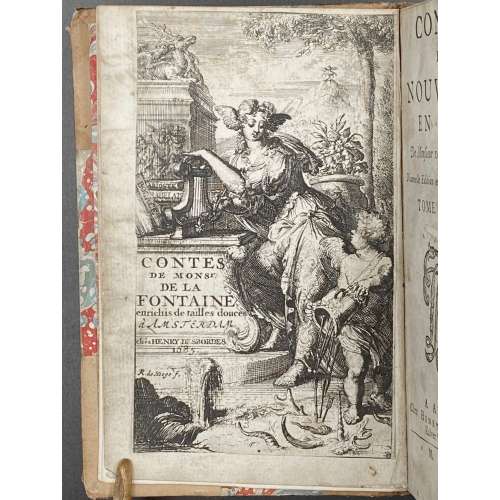 [Jean de LA FONTAINE]. Contes et nouvelles en vers. De Monsieur de La Fontaine. Nouvelle édition enrichie de tailles-douces. À Amsterdam | Chez Henry Desbordes, MDCLXXXV [1685]. — 2 vol. in 1. Pagination: [1] - frontispiece with pasted illustr., [*1] - title p. with blank verso, *2-*5 (only recto numbered) - advertisement, [1] - preface vol. 1, [2] table, 1-236; [6] - preface vol. 2, 1-216, illustr. (in text). Etched frontispiece plate and 58 half-page etchings at the head of each chapter as well as endpiece vignettes, all by R. de Hooge (Romeyn de Hooghe, 1645 – 1708, a Dutch painter, sculptor, engraver and caricaturist. First illustrated edition. "Publication of the scandalous fables was forbidden in France from 1674. According to Van Eeghen, this edition was published without the knowledge of La Fontaine. ...This is the edition with ‘Le Juge de Nêle’ (instead of Mesle) in the contents of the first volume, as well as page 211 for 'Dissertation sur la Joconde'; 16 lines of text on page 211; and 19 lines of text on the first page of the preface of volume 2" [1]. Pott 8vo (15.4 x 10 cm), hardcover; owner's later tan polished half-calf, marbled boards, marbled pastedowns and flyleaves, 5 raised bands, dark brown labels with gilt lettering and gilt roll patterns on spine, tail of the spine slightly damaged. Corners bumped, spotted stains on leather. Henri Desbordes (d. ca. 1722) was a Huguenot printer who was exiled from his business in France and set up as a publisher in Amsterdam in the 17th century.
[Jean de LA FONTAINE]. Contes et nouvelles en vers. De Monsieur de La Fontaine. Nouvelle édition enrichie de tailles-douces. À Amsterdam | Chez Henry Desbordes, MDCLXXXV [1685]. — 2 vol. in 1. Pagination: [1] - frontispiece with pasted illustr., [*1] - title p. with blank verso, *2-*5 (only recto numbered) - advertisement, [1] - preface vol. 1, [2] table, 1-236; [6] - preface vol. 2, 1-216, illustr. (in text). Etched frontispiece plate and 58 half-page etchings at the head of each chapter as well as endpiece vignettes, all by R. de Hooge (Romeyn de Hooghe, 1645 – 1708, a Dutch painter, sculptor, engraver and caricaturist. First illustrated edition. "Publication of the scandalous fables was forbidden in France from 1674. According to Van Eeghen, this edition was published without the knowledge of La Fontaine. ...This is the edition with ‘Le Juge de Nêle’ (instead of Mesle) in the contents of the first volume, as well as page 211 for 'Dissertation sur la Joconde'; 16 lines of text on page 211; and 19 lines of text on the first page of the preface of volume 2" [1]. Pott 8vo (15.4 x 10 cm), hardcover; owner's later tan polished half-calf, marbled boards, marbled pastedowns and flyleaves, 5 raised bands, dark brown labels with gilt lettering and gilt roll patterns on spine, tail of the spine slightly damaged. Corners bumped, spotted stains on leather. Henri Desbordes (d. ca. 1722) was a Huguenot printer who was exiled from his business in France and set up as a publisher in Amsterdam in the 17th century. -
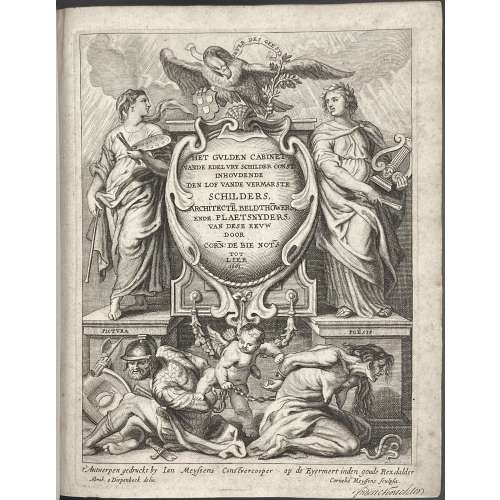 Engraved title page:
Engraved title page:- In an oval cartouche at the centre, flanked by female personifications of Painting and Poetry, surmounted by an eagle, Mars and Envy chained by Cupid below: HET GULDEN CABINET | VANDE EDEL VRY SCHILDER, CONST | INHOUDENDE | DEN LOF VANDE VERMARSTE | SCHILDERS, | ARCHITECTE, BELDTHOWERS | ENDE PLAETSNYDERS | VAN DESE EEVW | DOOR | CORN: DE BIE NOTS. | TOT | LIER | 1661. ||
- In lower margin below the image frame: t’Antwerpen gedruckt by Ian Meyssens Constvercooper op de Eyermert inden goude Rexdalder | Abrah. a Diepenbeck delin. — Cornelis Meyssens sculpsit. || Handwritten inscription below: Frederik Verachter
Cornelis de Bie. Het Gulden Cabinet. — Antwerp: [J. van Montfort for] Jan Meyssens, 1661 [colophon: 1662]. First edition, quarto, with engraved title, added portrait of De Bie dated 1708 mounted and inserted*, illustrated with 97 full-page engravings of artists, and an engraving of a personification of the city of Rome repeated five times; bound in full contemporary Dutch parchment over boards, tooled in blind, titled on spine; ex libris Frederik Verachter (Dutch, 1797 – 1870), archivist of the Antwerp city library, with pages of notes in his hand, signature to title, and inserted leaf with extra biographical information about one of the 280 artists of the Low Countries profiled and illustrated in this volume; contents good; ex libris Gustave Van Havre (Dutch, 1817 – 1892), with his armorial bookplate inside the front board, 24 x 19.5 x 4.5 cm.
Catalogue raisonné: J. F. Van Someren (1888) pp. 200-202. * CORNELIUS DE BIE. ÆT. 81. 1708. | Dat Ick op D'aard Niet Anders Ben | Als Stof En Assen Ick Beken: | En Alle Mijnen Arrebeijd | Noch Van Veel Minder Weerdigheijt. || J. C. de Cock delin: — H. F. diamaer Sculpsit Antv: Ref.: Royal Collection Trust. Backer, Jacob de (Flemish, c. 1555 – c. 1585) (artist) Balen, Jan van (Flemish, 1611 – 1654) (artist) Bally, David (Dutch, 1584 – 1657) (artist) Beck, David [Beek] (Dutch, 1621 – 1656) (artist) Bie, Cornelis de (Flemish, 1627 – 1711) (author) Bloemaert, Abraham (Dutch, 1565 – 1658) (artist) Borcht I, Hendrik van der, the Elder (Flemish, 1583 – 1651) (artist) Borcht II, Hendrik van der, the Younger (German 1614 – 1676) (artist) Bouttats, Frederik, the Elder (Flemish, 1590 – 1661) (attributed to) (engraver) Bramer, Leonard [Leendert] (Dutch, 1596 – 1674) (artist) Bronckhorst, Jan Gerritsz van (Dutch, 1603-1661) (artist) Bylert, Jan van (Dutch, 1603 – 1671) (artist) Caukercken, Cornelis van (Flemish, 1626 – 1680) (engraver) Collin, Richard (Luxembourgish, 1627 – 1698) (engraver) Coques, Gonzales (Flemish, 1614 – 1684) (artist) Cossiers, Joannes (Flemish, 1600 – 1671) (artist) Danckerts de Rij, Peter (Dutch, 1605-1660) (artist) Dipenbeeck, Abraham van (Dutch, 1596 – 1675) (artist) Does, Antony van der (Flemish, 1609 –1680) (engraver) Dyck, Anthony van (Flemish, 1599 – 1641) (artist) François, Pierre (fl. 1643) (artist) Hecke, Jan van den, the Elder (Flemish, 1620 – 1684) (engraver) Heil, Daniel van (Flemish, 1604 – 1664) (artist) Heil, Jan Baptiste van (Flemish, 1609 – 1685) (artist) Heil, Leo van (Flemish, 1605 – c. 1664) (artist) Helt Stockade, Nicolaes van (Dutch, 1614 – 1669) (artist) Hollar, Wenceslaus [Hollar, Václav; Wenzel] ( Bohemian, 1607 – 1677) (artist) Hondius I, Hendrick [de Hondt] (Flemish-Dutch, 1573 – 1650) (artist) Janssens, Cornelis van Ceulen [Johnson, Cornelius] (Flemish-Dutch, 1593-1664) (artist) Jode I, Pieter de, the Elder (1570 – 1634) (engraver) Jordaens, Jacob (Flemish, 1593 – 1678) (artist) Lint, Peter van (Flemish, 1609 – 1690) (artist) Meyssens, Cornelis (Flemish, 1639 – fl.1673) (engraver) Meyssens, Joannes [Johannes, Jan, Jean] (Flemish, 1612 – 1670) Mola, Pier Francesco (Italian, 1612 – 1666) (artist) Monte, Deodat del [Mont, Deodat van der; Delmont, Deodatus] (Flemish, 1582 – 1644) (artist) Montfort, Jan van (fl. c. 1595 – 1644) (printer) Padoanino, Francisco (Italian, 1660) (artist) Poelenburgh, Cornelis van [Poelenburch] (Dutch, 1594 – 1667) (artist) Pontius, Paulus (Flemish, 1603 – 1658) (engraver) Quellinus, Erasmus, the Younger (Flemish, 1607 – 1678) (artist) Reni, Guido (Italian, 1575 – 1642) (artist) Sadeler II, Egidius (Flemish, c.1570 – 1629) (artist) Saftleven, Herman, the Younger (Dutch, 1609 – 1685) (artist) Seghers, Gerard (Flemish, 1591 - 1651) (artist) Snyers, Hendrik (Flemish, 1611 – 1644) (engraver) Soutman, Pieter Claesz (Dutch, 1593/1601 – 1657) (artist) Steen, Franciscus van der (Flemish, 1625 – 1672) (engraver) Teniers, David, the Younger (Flemish, 1610 – 1690) (artist) Venne, Adriaen van de [Adriaen Pietersz] (Dutch, 1589 – 1662) (artist) Voet, Alexander, the Elder (Flemish, 16-8/1613 – 1689) (engraver) Vorsterman, Lucas, the Elder (Flemish, 1595-1675) (engraver) Waumans, Conraed (Flemish, 1619 – 1675) (engraver) Willaerts, Adam (Dutch, 1577 – 1664) (artist) -
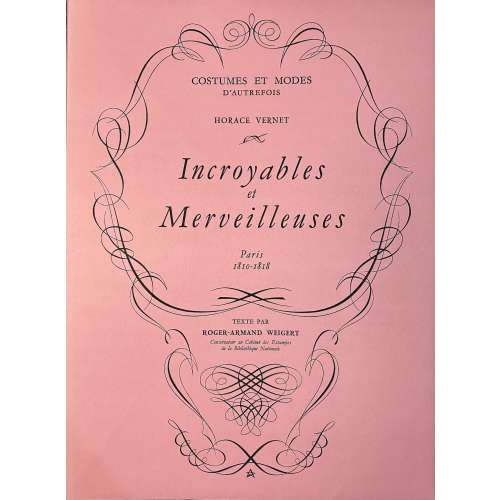 Title: COSTUMES ET MODES | D’AUTREFOIS | HORACE VERNET | Incroyables | et | Merveilleuses | Paris | 1810–1818 | TEXTE PAR | ROGER–ARMAND WEIGERT | Conservateur au Cabinet des Estampes | de la Bibliothèque Nationale | ÉDITIONS ROMBALDI | PARIS || Content: 24 photomechanical reproductions of the images from Bibliothèque nationale de France, printed on vélin paper from Papeteries Aussedat by Papeteries de la Moselle printing presses and stencil-coloured by Edmond Vairel. Text printed by Imprimerie Kapp on October 20, 1955. A print run of 4,000 copies, of which this is №122. Exterior: Pink lettered dust jacket over wrappers. Pagination: loose double leaves, [4 blanks] [4 h.t. and t.p.], i-xi [xii], 24 unnumbered plates, [4 blanks].
Title: COSTUMES ET MODES | D’AUTREFOIS | HORACE VERNET | Incroyables | et | Merveilleuses | Paris | 1810–1818 | TEXTE PAR | ROGER–ARMAND WEIGERT | Conservateur au Cabinet des Estampes | de la Bibliothèque Nationale | ÉDITIONS ROMBALDI | PARIS || Content: 24 photomechanical reproductions of the images from Bibliothèque nationale de France, printed on vélin paper from Papeteries Aussedat by Papeteries de la Moselle printing presses and stencil-coloured by Edmond Vairel. Text printed by Imprimerie Kapp on October 20, 1955. A print run of 4,000 copies, of which this is №122. Exterior: Pink lettered dust jacket over wrappers. Pagination: loose double leaves, [4 blanks] [4 h.t. and t.p.], i-xi [xii], 24 unnumbered plates, [4 blanks].Weigert, Roger-Armand (French, 1907-1986).
Émile Jean-Horace Vernet [Horace Vernet] (French, 1789 – 1863). Gatine, Georges Jacques (French, 1773 – after 1841). -
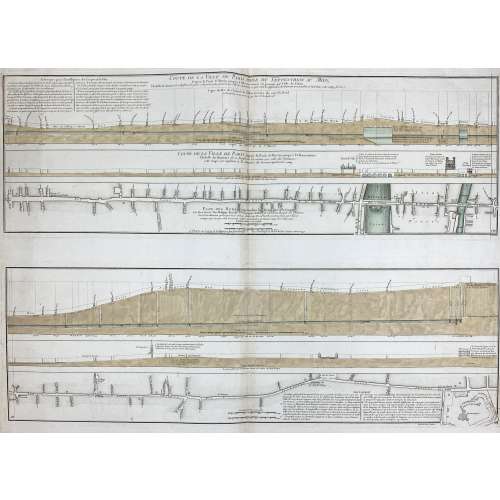
Two prints on one sheet of watermarked laid paper.
Coupe de la ville de Paris prise du septentrion au midy, depuis la porte St Martin jusqu'à l'Observatoire en passant par l'isle du Palais... Coupe de la ville de Paris depuis la porte St Martin jusqu'à l'Observatoire... Plan des rues comprises dans la direction dela coupe... / Le tout dressé par Philippe Buache... ; Desbruslins, sculpsit.
Watermark: "IHS" within circle; countermark of "FIN/ DUPUY/ AUVERGNE 1749".
LOC dates it to 1757. Gallica – to 1742, though the watermark is 1749.
-
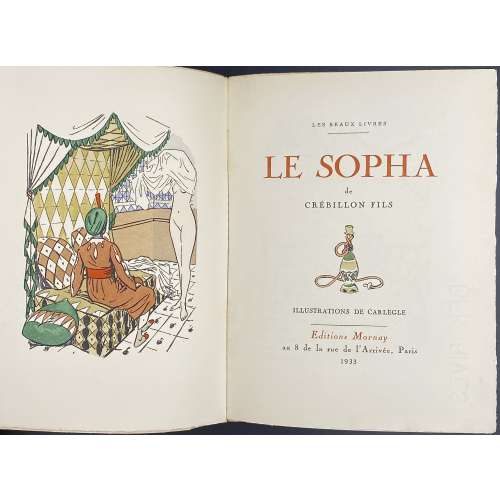 Title: LES BEAUX LIVRES | — | LE SOPHA | de | CRÉBILLON FILS |{vignette}| ILLUSTRATIONS DE CARLÈGLE | — | Éditions Mornay | au 8 de la rue de l’Arrivée, Paris | 1933 || Series: Les beaux livres Binding: Original pictorial wrappers, margins untrimmed, uncut; printed on BFK Rives paper (watermark); the number of copy blacked out. Justification of the print run on p. [329].Pagination: [1-8] 9-326 [327-331], ill., woodcuts in text. Size: 20.2 x 15.5 cm
Title: LES BEAUX LIVRES | — | LE SOPHA | de | CRÉBILLON FILS |{vignette}| ILLUSTRATIONS DE CARLÈGLE | — | Éditions Mornay | au 8 de la rue de l’Arrivée, Paris | 1933 || Series: Les beaux livres Binding: Original pictorial wrappers, margins untrimmed, uncut; printed on BFK Rives paper (watermark); the number of copy blacked out. Justification of the print run on p. [329].Pagination: [1-8] 9-326 [327-331], ill., woodcuts in text. Size: 20.2 x 15.5 cm -
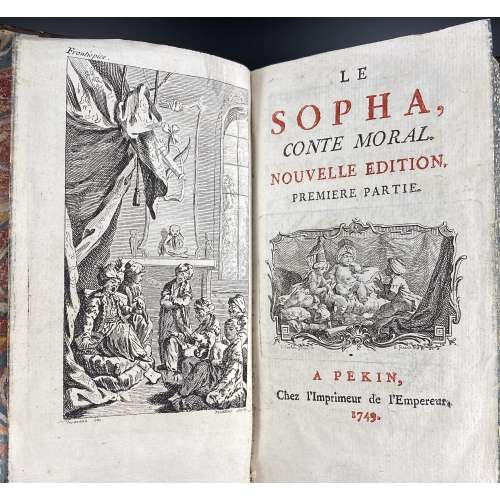 Title-page in black and red: LE | SOPHA, | CONTE MORAL. | NOUVELLE EDITION. | PREMIERE PARTIE. | {vignette} | A PEKIN, | Chez l'imprimeur de l'Empereur, | 1749. || Pagination: Two volumes in one. [2] – blanks, [2] – blank / frontis., [i, ii] – t.p. / blank, [iii] iv-xxi [xxii] ; [1] 2-253, [254-256] – table / blank, [2] – blanks; [i, ii] f.t. (seconde partie). [iii] 4-237 [238-240] – table / blank, [2] – blanks ; ills. 1 frontispiece, 4 plates and 2 vignettes by Pelletier after Clavereau, 2 fleurons by Fessard after Cochin. Collation: 12mo; a12, A8B4–T8V4, X8 [*1]; A8B4–T8V4. Binding: Full mottled calf, flat spine, compartments double-ruled in gilt, gilt flowers and foliage in compartments, crimson title label; marbled endpapers. Printed on laid paper, watermarked. Size: 14.8 x 8.8 cm Catalogue raisonné: Cohen, de Ricci (266); J. Lewine (124-5).
Title-page in black and red: LE | SOPHA, | CONTE MORAL. | NOUVELLE EDITION. | PREMIERE PARTIE. | {vignette} | A PEKIN, | Chez l'imprimeur de l'Empereur, | 1749. || Pagination: Two volumes in one. [2] – blanks, [2] – blank / frontis., [i, ii] – t.p. / blank, [iii] iv-xxi [xxii] ; [1] 2-253, [254-256] – table / blank, [2] – blanks; [i, ii] f.t. (seconde partie). [iii] 4-237 [238-240] – table / blank, [2] – blanks ; ills. 1 frontispiece, 4 plates and 2 vignettes by Pelletier after Clavereau, 2 fleurons by Fessard after Cochin. Collation: 12mo; a12, A8B4–T8V4, X8 [*1]; A8B4–T8V4. Binding: Full mottled calf, flat spine, compartments double-ruled in gilt, gilt flowers and foliage in compartments, crimson title label; marbled endpapers. Printed on laid paper, watermarked. Size: 14.8 x 8.8 cm Catalogue raisonné: Cohen, de Ricci (266); J. Lewine (124-5). -
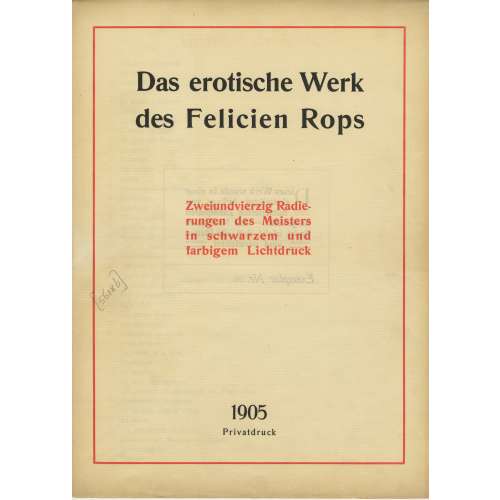
A limited-edition (№26/500) set of 42 etchings and drypoints after Félicien Rops (Belgian, 1833 – 1898), each mounted in a numbered passe-partout, printed posthumously by an anonym in Germany in 1905; in a flapped half faux suede-backed cardboard portfolio with straps, 442 x 335 mm, red embossed lettering to the front cover, bookplate of Richard Teschner (Austrian, 1879 – 1948) pasted inside.
Title-page (in a red frame): Das erotische Werk | des Felicien Rops | Zweiundvierzig Radie- | rungen des Meisters | in schwarzem und | farbigem Lichtdruck | 1905 | Privatdruk ||
Limitation (in a red two-section frame) : Dieses Werk wurde in einer | einmaligen Auflage von | 500 numerierten Exemplaren | hergestellt. — Ein Nachdruck | findet nicht statt, die Platten | == sind vernichtet == | Exemplar Nr. 26 ||
Verzeichnis der Tafeln (Table of Contents): 1. Initiation sentimentale; 2. La croix; 3. Entre-acte; 4. Holocauste; 5. La bonne hollandaise; 6. Étude; 7. La femme au pantin; 8. L’amour de Satan; 9. Au pays des féminies; 10. La volupté; 11. Evocation; 12. De castitate; 13. Joujou; 14. Vengeance d’une femme; 15. Phantasies; 16. Indolence; 17. Théâtre gaillard; 18. Appel au peuple; 19. Masques modernes; 20. Tout est grand chez les rois; 21. Marie-Madeleine; 22. L’amante du Christ; 23. Feuille de vigne; 24. La messe de Guide; 25 Viol et prostitution; 26. Le maillot; 27. Les jeunes France; 28. Les diaboliques; 29. Coquetterie au miroir; 30. Jeune homme; 31. La femme et la mort; 32. Confidence; 33. La bergère; 34. La mère aux satyrions; 35. Les exercices de dévotion de Mr. Henri Roch; 36. Mademoiselle de Maupin; 37. Le bonheur dans le crime; 38. La sirène; 39. Les cabotinages de l’amour; 40. Document sur l’impuissance d’aimer; 41. A cœur perdu; 42. Curieuse.
-
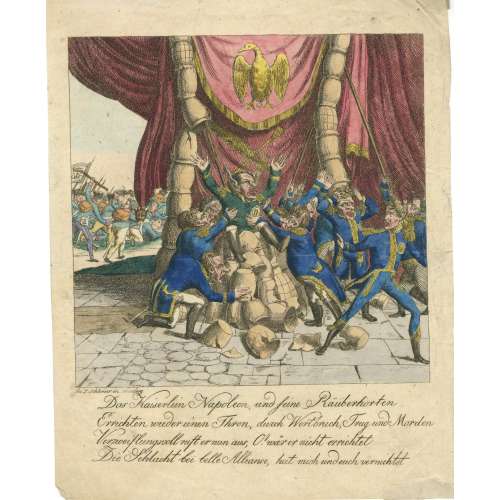 Hand-coloured etching by L. Schlemer from Nürnberg, printed in c. 1815. Napoleon, with long ears, is seated on a throne made of a pile of crockery, which is falling over. Referring to the Battle of Waterloo. See p. 134 in vol. 2 of A. M. Broadley. Napoleon in caricature, 1795-1821. — London, New York: John Lane, 1911.
Hand-coloured etching by L. Schlemer from Nürnberg, printed in c. 1815. Napoleon, with long ears, is seated on a throne made of a pile of crockery, which is falling over. Referring to the Battle of Waterloo. See p. 134 in vol. 2 of A. M. Broadley. Napoleon in caricature, 1795-1821. — London, New York: John Lane, 1911. -
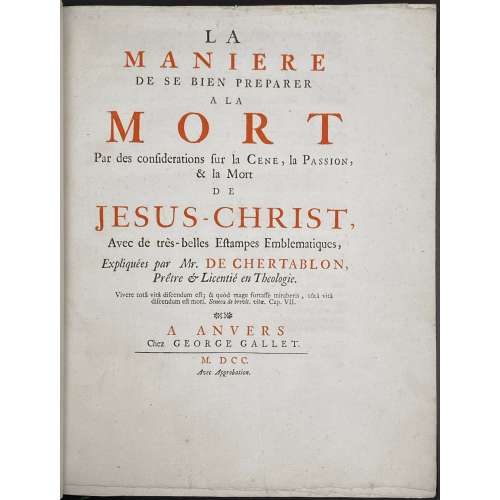 M. de Chertablon. La maniere de se bien preparer a la Mort par des Considerations sur la Cene, la Passion, et la Mort de Jesu-Christ. – Antwerp: George Gallet, 1700. Pagination: ff, [2 - blanks] [2 - t.p., blank] [3 - advert.] 4-63 [64]; 42 copper etched plates by Romeyn de Hooghe: A, B, C, 1-39; [20 - Dutch plate description of the David de la Vigne's Miroir de la bonne mort], bf. Full title: La maniere de se bien preparer a la Mort par des Considerations sur la Cene, la Passion, et la Mort de Jesu-Christ, Avec de très-belles Estampes Emblematiques, Expliquées par Mr. de Chertablon, Piêtre & Licentié en Theologie. Vivere totâ vitâ discendum est; & quòd mage fortasse miraberis, tôtâ vitâ discendum est mori. Seneca de brevit. vitæ. Cap. VII. A Anvers, Chez George Gallet. M DCC, Avec Approbation. / David de La Vigne. Spiegel om wel te sterven, annwyzende met beeltenissen van het lyden onses zaligmaakers Jesu Christi. Verzierd met 42 fyne Geërste Kopere Platen, Door Romain de Hooghe; Te Amsterdam, Voor dezen gedrukt by J. Stigter. Size: 4to, 27.2 x 21.6 cm. Binding: Late 19th century brown calf over marbled boards, spine with gilt lettering, raised bands, double fillet blind panels in compartments; marbled end-papers; bookplate of Samuel Ashton Thompson Yates library, AD 1894. Book illustrated with 42 copperplate etched engravings by Romeyn de Hooghe (Dutch, Amsterdam 1645–1708 Haarlem). According to Bonhams: the plates were "first printed for David de la Vigne's Miroir de la bonne mort. Each of the plates depicts a man contemplating a religious image in order to ease the passing of death, accompanied by commentary and an appropriate verse of scripture for each plate. The present French edition is bound with, as issued, the Dutch translation of David de La Vigne's aforementioned work."
M. de Chertablon. La maniere de se bien preparer a la Mort par des Considerations sur la Cene, la Passion, et la Mort de Jesu-Christ. – Antwerp: George Gallet, 1700. Pagination: ff, [2 - blanks] [2 - t.p., blank] [3 - advert.] 4-63 [64]; 42 copper etched plates by Romeyn de Hooghe: A, B, C, 1-39; [20 - Dutch plate description of the David de la Vigne's Miroir de la bonne mort], bf. Full title: La maniere de se bien preparer a la Mort par des Considerations sur la Cene, la Passion, et la Mort de Jesu-Christ, Avec de très-belles Estampes Emblematiques, Expliquées par Mr. de Chertablon, Piêtre & Licentié en Theologie. Vivere totâ vitâ discendum est; & quòd mage fortasse miraberis, tôtâ vitâ discendum est mori. Seneca de brevit. vitæ. Cap. VII. A Anvers, Chez George Gallet. M DCC, Avec Approbation. / David de La Vigne. Spiegel om wel te sterven, annwyzende met beeltenissen van het lyden onses zaligmaakers Jesu Christi. Verzierd met 42 fyne Geërste Kopere Platen, Door Romain de Hooghe; Te Amsterdam, Voor dezen gedrukt by J. Stigter. Size: 4to, 27.2 x 21.6 cm. Binding: Late 19th century brown calf over marbled boards, spine with gilt lettering, raised bands, double fillet blind panels in compartments; marbled end-papers; bookplate of Samuel Ashton Thompson Yates library, AD 1894. Book illustrated with 42 copperplate etched engravings by Romeyn de Hooghe (Dutch, Amsterdam 1645–1708 Haarlem). According to Bonhams: the plates were "first printed for David de la Vigne's Miroir de la bonne mort. Each of the plates depicts a man contemplating a religious image in order to ease the passing of death, accompanied by commentary and an appropriate verse of scripture for each plate. The present French edition is bound with, as issued, the Dutch translation of David de La Vigne's aforementioned work." -
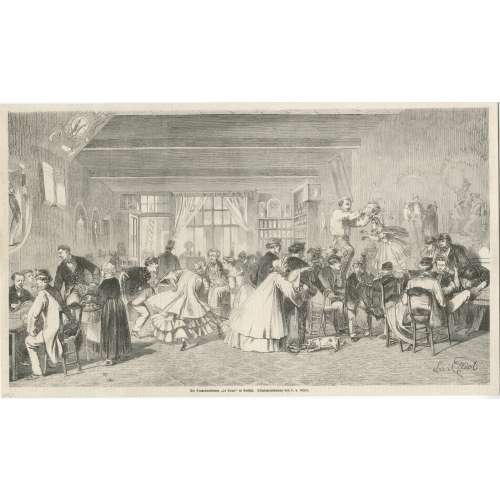
A woodcut illustration after drawing by Leo von Elliot, published at Illustrirte Zeitung, 17 January 1863. English translation: Student bar "The Hole" in Brussels.
The official name of this bar, located at Rue des Sols in Bussels, was "À la vue de l'Université" (In sight of the University). This was the place where the students of the Université libre de Bruxelles (Free University of Brussels), and especially the members of Société, ou Cercle, des Crocodiles (The Crocodile Society, or Circle), gathered in the 1860s. -
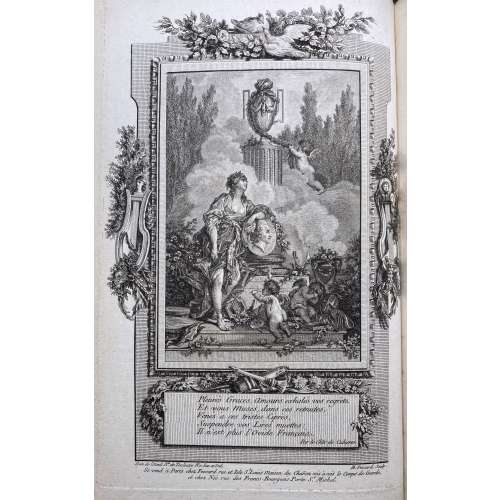 Title page: LES | BAISERS , | PRÉCÉDES | DU MOIS DE MAI, | POËME. | [vignette] | A LA HAYE , | Et se trouve à Paris | Chez Lambert , Imprimeur, rue de la Harpe. | Et Delalain , rue de la Comédie Françoise. | M. DCC. LXX Size: 8vo; 24.5 x 15.5 cm; Binding by Hippolyte Duru – stamp at the back of the front end paper DURU, 1855; full red calf, boards decorated in gilt, raised bands and gilt decorations in compartments, gilt lettering, AEG, peacock marbled end papers, text and illustrations printed on Holland paper. Collation: 2 ffls, engraved half-title by N. Ponce after Ch. Eisen, frontispiece by Etienne Fessard after Claude-Jean-Baptiste Hoin (French, 1750 – 1817) w/guard tissue, t.p. by J. Aliamet after Ch. Eisen, Réflexions préliminaires: A8, B4; 'Le Mois de Mai' half-title, imprim. note on verso, frontispice by De Longueil after Ch. Eisen w/guard tissue, A4 C-F(8) H4; 2bfls. Frontispiece by Etienne Fessard is unique in this edition. Pagination: [2] 3-24, [27]/28, 5/6, 31/32 31/34 11/12 37-119 [120], 22 head-pieces after Ch. Eisen and 22 end-pieces after Marillier, engraved by Baquoy, Binet, Delaunay, Lingée, De Longueil, Masquelier, Massard, and Née. Mistakes in pagination likely confirms first printing first edition. Catalogue raisonné: Cohen, De Ricci (1912): 308-311). Artists: Charles Eisen (French, 1720–1778); Clément Pierre Marillier (French, 1740–1808), and Claude-Jean-Baptiste Hoin (French, 1750–1817). Engravers: Jacques Aliamet (French, 1726–1788); Jean Charles Baquoy (French, 1721–1777); Louis Binet (French, 1744–about 1800); Nicolas Delaunay (French, 1739–1792); Etienne Fessard (French, 1714–1777); Charles Louis Lingée (French, 1748–1819); Joseph de Longueil (French, 1730–1792); Louis Joseph Masquelier (French, 1741–1811); Jean Massard (1740–1822); François Denis Née (French, 1735–1818); Nicholas Ponce (French, 1746–1831).
Title page: LES | BAISERS , | PRÉCÉDES | DU MOIS DE MAI, | POËME. | [vignette] | A LA HAYE , | Et se trouve à Paris | Chez Lambert , Imprimeur, rue de la Harpe. | Et Delalain , rue de la Comédie Françoise. | M. DCC. LXX Size: 8vo; 24.5 x 15.5 cm; Binding by Hippolyte Duru – stamp at the back of the front end paper DURU, 1855; full red calf, boards decorated in gilt, raised bands and gilt decorations in compartments, gilt lettering, AEG, peacock marbled end papers, text and illustrations printed on Holland paper. Collation: 2 ffls, engraved half-title by N. Ponce after Ch. Eisen, frontispiece by Etienne Fessard after Claude-Jean-Baptiste Hoin (French, 1750 – 1817) w/guard tissue, t.p. by J. Aliamet after Ch. Eisen, Réflexions préliminaires: A8, B4; 'Le Mois de Mai' half-title, imprim. note on verso, frontispice by De Longueil after Ch. Eisen w/guard tissue, A4 C-F(8) H4; 2bfls. Frontispiece by Etienne Fessard is unique in this edition. Pagination: [2] 3-24, [27]/28, 5/6, 31/32 31/34 11/12 37-119 [120], 22 head-pieces after Ch. Eisen and 22 end-pieces after Marillier, engraved by Baquoy, Binet, Delaunay, Lingée, De Longueil, Masquelier, Massard, and Née. Mistakes in pagination likely confirms first printing first edition. Catalogue raisonné: Cohen, De Ricci (1912): 308-311). Artists: Charles Eisen (French, 1720–1778); Clément Pierre Marillier (French, 1740–1808), and Claude-Jean-Baptiste Hoin (French, 1750–1817). Engravers: Jacques Aliamet (French, 1726–1788); Jean Charles Baquoy (French, 1721–1777); Louis Binet (French, 1744–about 1800); Nicolas Delaunay (French, 1739–1792); Etienne Fessard (French, 1714–1777); Charles Louis Lingée (French, 1748–1819); Joseph de Longueil (French, 1730–1792); Louis Joseph Masquelier (French, 1741–1811); Jean Massard (1740–1822); François Denis Née (French, 1735–1818); Nicholas Ponce (French, 1746–1831). -
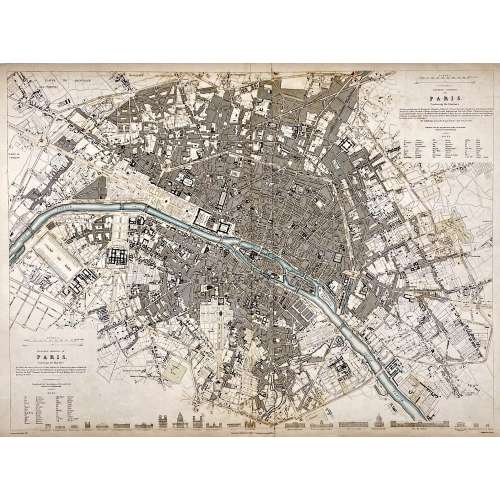 Top right: EASTERN DIVISION OF | PARIS. | Containing the Quartiers | {5 lines in italic} | Published under the Superintendence of the Society for the | Diffusion of Useful Knowledge || Bottom left: WESTERN DIVISION OF | PARIS. | Containing the Quartiers | {4 lines in italic} | Published under the Superintendence of the Society for the | Diffusion of Useful Knowledge || Under the frame: Drawn by W. B. Clarke, Archt. […] Published by Baldwin & Cradock, 47 Paternoster Row, A April 1st, 1834. [...] Engraved by J. Shury || Dimensions: Sheet: 40.8 x 57 cm; Image: 38.7 x 52.5 cm. Contributors: William Barnard Clarke (British, 1806 – 1865) – artist. John Shury (fl. c. 1814-1844) – engraver. Baldwin & Cradock (London) – publisher. Society for the Diffusion of Useful Knowledge (SDUK) (British firm, 1826 – 1846).
Top right: EASTERN DIVISION OF | PARIS. | Containing the Quartiers | {5 lines in italic} | Published under the Superintendence of the Society for the | Diffusion of Useful Knowledge || Bottom left: WESTERN DIVISION OF | PARIS. | Containing the Quartiers | {4 lines in italic} | Published under the Superintendence of the Society for the | Diffusion of Useful Knowledge || Under the frame: Drawn by W. B. Clarke, Archt. […] Published by Baldwin & Cradock, 47 Paternoster Row, A April 1st, 1834. [...] Engraved by J. Shury || Dimensions: Sheet: 40.8 x 57 cm; Image: 38.7 x 52.5 cm. Contributors: William Barnard Clarke (British, 1806 – 1865) – artist. John Shury (fl. c. 1814-1844) – engraver. Baldwin & Cradock (London) – publisher. Society for the Diffusion of Useful Knowledge (SDUK) (British firm, 1826 – 1846). -
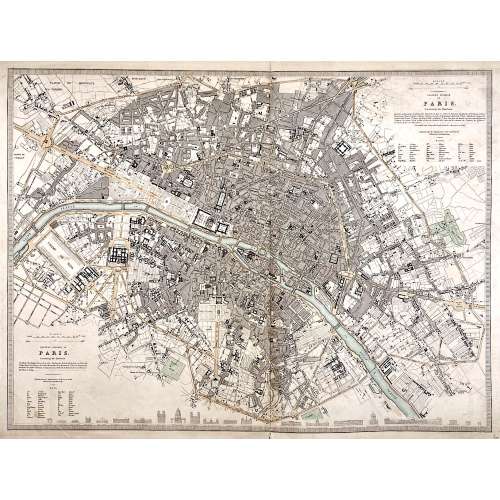 Top right: EASTERN DIVISION OF | PARIS. | Containing the Quartiers | {5 lines in italic} | Published under the Superintendence of the Society for the | Diffusion of Useful Knowledge || Bottom left: WESTERN DIVISION OF | PARIS. | Containing the Quartiers | {4 lines in italic} | Published under the Superintendence of the Society for the | Diffusion of Useful Knowledge || The map is framed, but there is no lettering beneath the frame to identify the cartographer, engraver, and publisher. However, we can attribute it to William Barnard Clarke (British, 1806 – 1865) and John Shury (fl. c. 1814-1844). The publisher is either Baldwin & Cradock or Chapman and Hall. Dimensions: Sheet: 40 x 60.8 cm; Image: 40 x 53.5 cm.
Top right: EASTERN DIVISION OF | PARIS. | Containing the Quartiers | {5 lines in italic} | Published under the Superintendence of the Society for the | Diffusion of Useful Knowledge || Bottom left: WESTERN DIVISION OF | PARIS. | Containing the Quartiers | {4 lines in italic} | Published under the Superintendence of the Society for the | Diffusion of Useful Knowledge || The map is framed, but there is no lettering beneath the frame to identify the cartographer, engraver, and publisher. However, we can attribute it to William Barnard Clarke (British, 1806 – 1865) and John Shury (fl. c. 1814-1844). The publisher is either Baldwin & Cradock or Chapman and Hall. Dimensions: Sheet: 40 x 60.8 cm; Image: 40 x 53.5 cm. -
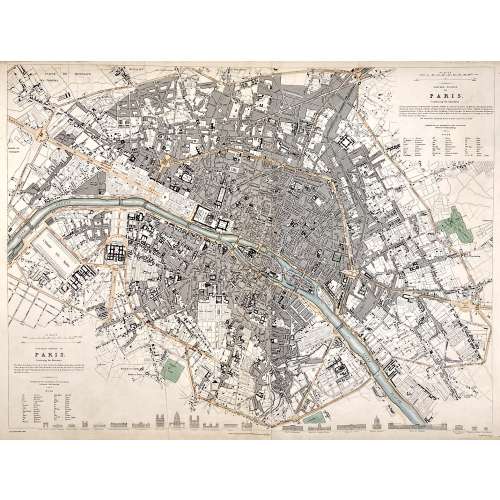 Top right: EASTERN DIVISION OF | PARIS. | Containing the Quartiers | {5 lines in italic} | Published under the Superintendence of the Society for the | Diffusion of Useful Knowledge || Bottom left: WESTERN DIVISION OF | PARIS. | Containing the Quartiers | {4 lines in italic} | Published under the Superintendence of the Society for the | Diffusion of Useful Knowledge || Under the frame: Drawn by W. B. Clarke, Archt. […] London: Published by Chapman and Hall, 186, Strand. April 1st, 1834. [...] Engraved by J. Shury || Dimensions: Sheet: 40.8 x 57 cm; Image: 38.7 x 52.5 cm. Contributors: William Barnard Clarke (British, 1806 – 1865) – artist. John Shury (fl. c. 1814-1844) – engraver. Chapman and Hall (London) – publisher. Society for the Diffusion of Useful Knowledge (SDUK) (British firm, 1826 – 1846).
Top right: EASTERN DIVISION OF | PARIS. | Containing the Quartiers | {5 lines in italic} | Published under the Superintendence of the Society for the | Diffusion of Useful Knowledge || Bottom left: WESTERN DIVISION OF | PARIS. | Containing the Quartiers | {4 lines in italic} | Published under the Superintendence of the Society for the | Diffusion of Useful Knowledge || Under the frame: Drawn by W. B. Clarke, Archt. […] London: Published by Chapman and Hall, 186, Strand. April 1st, 1834. [...] Engraved by J. Shury || Dimensions: Sheet: 40.8 x 57 cm; Image: 38.7 x 52.5 cm. Contributors: William Barnard Clarke (British, 1806 – 1865) – artist. John Shury (fl. c. 1814-1844) – engraver. Chapman and Hall (London) – publisher. Society for the Diffusion of Useful Knowledge (SDUK) (British firm, 1826 – 1846). -
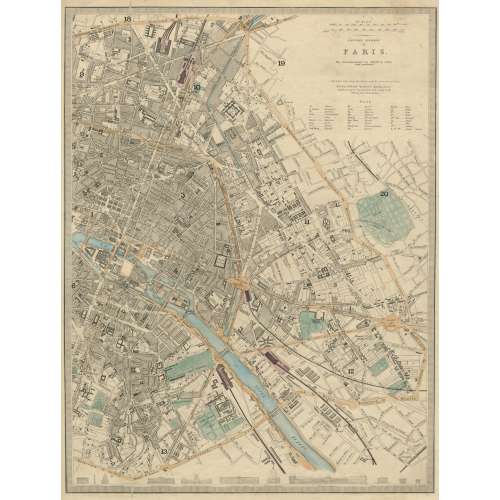 EASTERN DIVISION | OF | PARIS. | The Arrondissements are defined by colour | and numbered. || London, Edward Stanford 6 Charing Cross. | Published under the Superintendence of the Society for the Diffusion of Useful Knowledge. || Dimensions: Sheet: 43.5 x 35.5 cm; Image: 39.5 x 30 cm. Contributors: Edward Stanford (British, 1827 – 1904) – cartographer, engraver, publisher. Society for the Diffusion of Useful Knowledge (SDUK) (British firm, 1826 – 1846).
EASTERN DIVISION | OF | PARIS. | The Arrondissements are defined by colour | and numbered. || London, Edward Stanford 6 Charing Cross. | Published under the Superintendence of the Society for the Diffusion of Useful Knowledge. || Dimensions: Sheet: 43.5 x 35.5 cm; Image: 39.5 x 30 cm. Contributors: Edward Stanford (British, 1827 – 1904) – cartographer, engraver, publisher. Society for the Diffusion of Useful Knowledge (SDUK) (British firm, 1826 – 1846). -
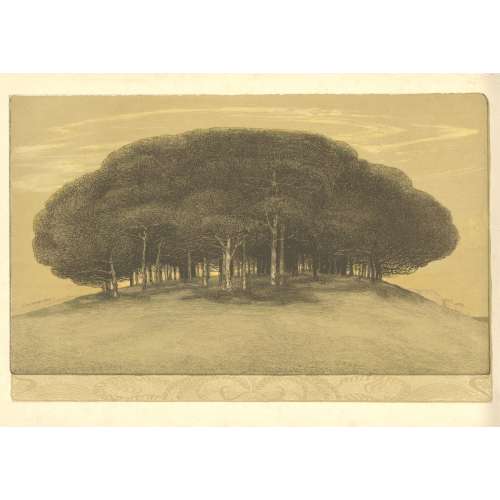 Colour (tone) lithography, image 268 x 410 mm, sheet 317 x 470 mm; signed on bottom-left of the image “Pelikan 1905”, and pencil ms inscription: E. Pelikan to the lower-right corner of the sheet. Contributor: Emilie Mediz-Pelikan (Austrian, 1861 – 1908) – artist. Seller's description: Austrian-German painter and graphic artist. Emilie Mediz-Pelikan was born in Vöcklabruck in 1861. She studied at the Vienna Academy and followed her teacher Albert Zimmermann to Salzburg and in 1885 to Munich. In 1891 she married the painter and graphic artist Karl Mediz (1868 - 1945), with whom she lived in Vienna and from 1894 in Dresden. She was in contact with the Dachau Artists' Colony and went on study trips to Paris, Belgium, Hungary and Italy. In the Dachau artists' colony she was friends with Adolf Hölzel and Fritz von Uhde. In 1889 and 1890 she spent time in Paris and in the Belgian artists' colony Knokke. In 1898 she was represented at the first art exhibition of the Vienna Secession, and in 1901 at the International Art Exhibition in Dresden. In 1903 she and her husband had a group exhibition, at the Hagenbund in Vienna. In 1904, she showed graphic works at the Dresden royal court art dealer Richter, and in 1905 and 1906 she exhibited at the Berlin Künstlerhaus. It was not until around 1900 that she achieved her artistic breakthrough with her landscape paintings. Since the estate of the artist, who died prematurely in Dresden in 1908, was lost in the former GDR until the 1980s, it was quite late that the artist was rediscovered and revalued both in Austrian art history and on the art market. In 1986, the first major exhibitions took place at the Upper Austrian State Museum and the University of Applied Arts in Vienna, followed by numerous smaller exhibitions in private galleries in Vienna, Linz and Munich. The artist received recognition during her lifetime from numerous prominent fellow painters as well as from the art critic Ludwig Hevesi. Together with Tina Blau, Herbert Boeckl, Marie Egner, Theodor von Hörmann, Franz Jaschke, Eugen Jettel, Ludwig Heinrich Jungnickel, Rudolf Junk, Gustav Klimt, Oskar Kokoschka, Johann Victor Krämer, Heinrich Kühn, Carl Moll, Rudolf Quittner, Rudolf Ribarz, Emil Jakob Schindler, Max Suppantschitsch, Max Weiler, Olga Wisinger-Florian and Alfred Zoff, she was a protagonist of the reception of Impressionism in Austria. This style went down in Austrian art history under the term "Stimmungsimpressionismus".
Colour (tone) lithography, image 268 x 410 mm, sheet 317 x 470 mm; signed on bottom-left of the image “Pelikan 1905”, and pencil ms inscription: E. Pelikan to the lower-right corner of the sheet. Contributor: Emilie Mediz-Pelikan (Austrian, 1861 – 1908) – artist. Seller's description: Austrian-German painter and graphic artist. Emilie Mediz-Pelikan was born in Vöcklabruck in 1861. She studied at the Vienna Academy and followed her teacher Albert Zimmermann to Salzburg and in 1885 to Munich. In 1891 she married the painter and graphic artist Karl Mediz (1868 - 1945), with whom she lived in Vienna and from 1894 in Dresden. She was in contact with the Dachau Artists' Colony and went on study trips to Paris, Belgium, Hungary and Italy. In the Dachau artists' colony she was friends with Adolf Hölzel and Fritz von Uhde. In 1889 and 1890 she spent time in Paris and in the Belgian artists' colony Knokke. In 1898 she was represented at the first art exhibition of the Vienna Secession, and in 1901 at the International Art Exhibition in Dresden. In 1903 she and her husband had a group exhibition, at the Hagenbund in Vienna. In 1904, she showed graphic works at the Dresden royal court art dealer Richter, and in 1905 and 1906 she exhibited at the Berlin Künstlerhaus. It was not until around 1900 that she achieved her artistic breakthrough with her landscape paintings. Since the estate of the artist, who died prematurely in Dresden in 1908, was lost in the former GDR until the 1980s, it was quite late that the artist was rediscovered and revalued both in Austrian art history and on the art market. In 1986, the first major exhibitions took place at the Upper Austrian State Museum and the University of Applied Arts in Vienna, followed by numerous smaller exhibitions in private galleries in Vienna, Linz and Munich. The artist received recognition during her lifetime from numerous prominent fellow painters as well as from the art critic Ludwig Hevesi. Together with Tina Blau, Herbert Boeckl, Marie Egner, Theodor von Hörmann, Franz Jaschke, Eugen Jettel, Ludwig Heinrich Jungnickel, Rudolf Junk, Gustav Klimt, Oskar Kokoschka, Johann Victor Krämer, Heinrich Kühn, Carl Moll, Rudolf Quittner, Rudolf Ribarz, Emil Jakob Schindler, Max Suppantschitsch, Max Weiler, Olga Wisinger-Florian and Alfred Zoff, she was a protagonist of the reception of Impressionism in Austria. This style went down in Austrian art history under the term "Stimmungsimpressionismus". -
 Colour (tone) lithography, image 396 x 508 mm, sheet 532 x 654 mm; before signature, undated; pencil ms inscription: Föhrenhain — E. Pelikan / 200M to the lower-right corner of the sheet. Contributor: Emilie Mediz-Pelikan (Austrian, 1861 – 1908) – artist. Seller's description: Austrian-German painter and graphic artist. Emilie Mediz-Pelikan was born in Vöcklabruck in 1861. She studied at the Vienna Academy and followed her teacher Albert Zimmermann to Salzburg and in 1885 to Munich. In 1891 she married the painter and graphic artist Karl Mediz (1868 - 1945), with whom she lived in Vienna and from 1894 in Dresden. She was in contact with the Dachau Artists' Colony and went on study trips to Paris, Belgium, Hungary and Italy. In the Dachau artists' colony she was friends with Adolf Hölzel and Fritz von Uhde. In 1889 and 1890 she spent time in Paris and in the Belgian artists' colony Knokke. In 1898 she was represented at the first art exhibition of the Vienna Secession, and in 1901 at the International Art Exhibition in Dresden. In 1903 she and her husband had a group exhibition, at the Hagenbund in Vienna. In 1904, she showed graphic works at the Dresden royal court art dealer Richter, and in 1905 and 1906 she exhibited at the Berlin Künstlerhaus. It was not until around 1900 that she achieved her artistic breakthrough with her landscape paintings. Since the estate of the artist, who died prematurely in Dresden in 1908, was lost in the former GDR until the 1980s, it was quite late that the artist was rediscovered and revalued both in Austrian art history and on the art market. In 1986, the first major exhibitions took place at the Upper Austrian State Museum and the University of Applied Arts in Vienna, followed by numerous smaller exhibitions in private galleries in Vienna, Linz and Munich. The artist received recognition during her lifetime from numerous prominent fellow painters as well as from the art critic Ludwig Hevesi. Together with Tina Blau, Herbert Boeckl, Marie Egner, Theodor von Hörmann, Franz Jaschke, Eugen Jettel, Ludwig Heinrich Jungnickel, Rudolf Junk, Gustav Klimt, Oskar Kokoschka, Johann Victor Krämer, Heinrich Kühn, Carl Moll, Rudolf Quittner, Rudolf Ribarz, Emil Jakob Schindler, Max Suppantschitsch, Max Weiler, Olga Wisinger-Florian and Alfred Zoff, she was a protagonist of the reception of Impressionism in Austria. This style went down in Austrian art history under the term "Stimmungsimpressionismus".
Colour (tone) lithography, image 396 x 508 mm, sheet 532 x 654 mm; before signature, undated; pencil ms inscription: Föhrenhain — E. Pelikan / 200M to the lower-right corner of the sheet. Contributor: Emilie Mediz-Pelikan (Austrian, 1861 – 1908) – artist. Seller's description: Austrian-German painter and graphic artist. Emilie Mediz-Pelikan was born in Vöcklabruck in 1861. She studied at the Vienna Academy and followed her teacher Albert Zimmermann to Salzburg and in 1885 to Munich. In 1891 she married the painter and graphic artist Karl Mediz (1868 - 1945), with whom she lived in Vienna and from 1894 in Dresden. She was in contact with the Dachau Artists' Colony and went on study trips to Paris, Belgium, Hungary and Italy. In the Dachau artists' colony she was friends with Adolf Hölzel and Fritz von Uhde. In 1889 and 1890 she spent time in Paris and in the Belgian artists' colony Knokke. In 1898 she was represented at the first art exhibition of the Vienna Secession, and in 1901 at the International Art Exhibition in Dresden. In 1903 she and her husband had a group exhibition, at the Hagenbund in Vienna. In 1904, she showed graphic works at the Dresden royal court art dealer Richter, and in 1905 and 1906 she exhibited at the Berlin Künstlerhaus. It was not until around 1900 that she achieved her artistic breakthrough with her landscape paintings. Since the estate of the artist, who died prematurely in Dresden in 1908, was lost in the former GDR until the 1980s, it was quite late that the artist was rediscovered and revalued both in Austrian art history and on the art market. In 1986, the first major exhibitions took place at the Upper Austrian State Museum and the University of Applied Arts in Vienna, followed by numerous smaller exhibitions in private galleries in Vienna, Linz and Munich. The artist received recognition during her lifetime from numerous prominent fellow painters as well as from the art critic Ludwig Hevesi. Together with Tina Blau, Herbert Boeckl, Marie Egner, Theodor von Hörmann, Franz Jaschke, Eugen Jettel, Ludwig Heinrich Jungnickel, Rudolf Junk, Gustav Klimt, Oskar Kokoschka, Johann Victor Krämer, Heinrich Kühn, Carl Moll, Rudolf Quittner, Rudolf Ribarz, Emil Jakob Schindler, Max Suppantschitsch, Max Weiler, Olga Wisinger-Florian and Alfred Zoff, she was a protagonist of the reception of Impressionism in Austria. This style went down in Austrian art history under the term "Stimmungsimpressionismus". -
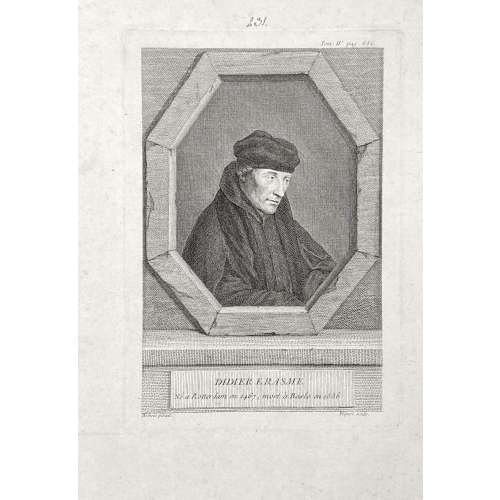 The portrait of Erasmus of Rotterdam (1466 – 1536), half-length, head to the right, body facing right, looking away, in a trompe-l'oeil octagonal frame. Inscriptions: Top right: Tom IV, pag. 686. Center of the image: DIDIER ERASME / Ne a Rotterdam en 1467, mort a Basle en 1536. Bottom of the plate: Holbein pinxit | Flipart Sculp. From the book Histoire générale des Provinces-Unies by Bénigne Dujardin (French, 1689 – 1771?) and Gottfried Sellius (real name Gottfried Sell) (1704? – 1767), published in 1757 in Paris by P. G. Simon. Volume 4, facing p. 686. Size: Sheet: 25 x 17.5 cm; Plate: 19.5 x 13.5 cm; Image: 18 x 12 cm. References: (1) Van Someren v.2, p.249, №1688; (2) https://archive.org/details/histoiregnra04duja/page/n714/mode/2up. Inscription above the plate: nut ink, hand, "231".
The portrait of Erasmus of Rotterdam (1466 – 1536), half-length, head to the right, body facing right, looking away, in a trompe-l'oeil octagonal frame. Inscriptions: Top right: Tom IV, pag. 686. Center of the image: DIDIER ERASME / Ne a Rotterdam en 1467, mort a Basle en 1536. Bottom of the plate: Holbein pinxit | Flipart Sculp. From the book Histoire générale des Provinces-Unies by Bénigne Dujardin (French, 1689 – 1771?) and Gottfried Sellius (real name Gottfried Sell) (1704? – 1767), published in 1757 in Paris by P. G. Simon. Volume 4, facing p. 686. Size: Sheet: 25 x 17.5 cm; Plate: 19.5 x 13.5 cm; Image: 18 x 12 cm. References: (1) Van Someren v.2, p.249, №1688; (2) https://archive.org/details/histoiregnra04duja/page/n714/mode/2up. Inscription above the plate: nut ink, hand, "231". -
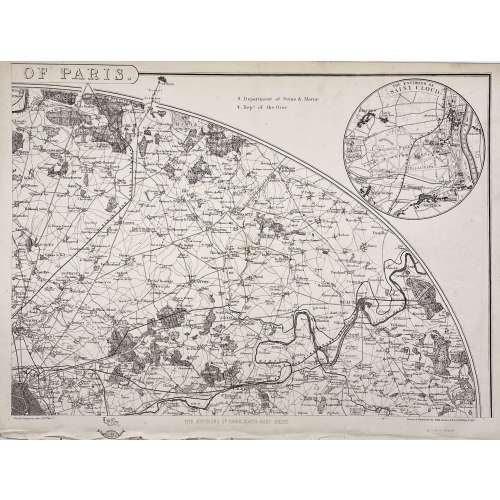 Four maps 34 x 47.5 cm each. Include insets of Versailles, Fontainebleau, Saint Cloud and St. Germain en Laye. Lithograph by Edward Weller after a map drawn and engraved by John Dower. "These maps originally appeared in the Weekly Dispatch newspaper from 1856 to 1862. They were reissued between 1863 and 1867 by Cassell, Petter and Galpin and then published collectively as Cassell's Atlas. The plates were acquired by G.W. Bacon & Co., and reissued in 1876 under the title Bacon's New Quarto Atlas ... of the Counties of England, and many times since under various titles." [WorldCat]
Four maps 34 x 47.5 cm each. Include insets of Versailles, Fontainebleau, Saint Cloud and St. Germain en Laye. Lithograph by Edward Weller after a map drawn and engraved by John Dower. "These maps originally appeared in the Weekly Dispatch newspaper from 1856 to 1862. They were reissued between 1863 and 1867 by Cassell, Petter and Galpin and then published collectively as Cassell's Atlas. The plates were acquired by G.W. Bacon & Co., and reissued in 1876 under the title Bacon's New Quarto Atlas ... of the Counties of England, and many times since under various titles." [WorldCat]Dimensions: 34 x 47.5 cm each.
Contributors: Weller, Edward (British, 1819 – 1884) – lithographer. Dower, John Crane (British, 1791 – 1847) – artist, engraver. Dower, John James (British, 1825 – 1901) – artist, engraver (son of John Crane Dower). -
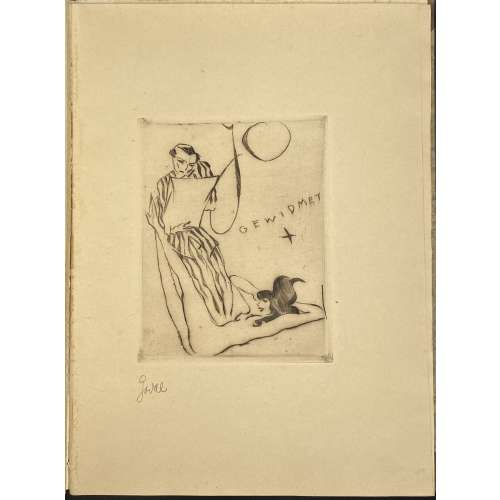 Half calf binding 33.5 x 25 cm, gilt lettering within rules “GODAL | JO”, engraved title-page and 9 etchings printed in sepia on sheets 32.5 x 24 cm of thick wove paper, pencil signed, presumably, by the artist; a newspaper clipping tipped-in. The number of copies is unknown. Ticket to front pastedown: "Haeusgen |8 München 90 | Reinekestrasse 36" According to seller: “Extraordinarily rare series of erotic original etchings. - Cf. Bilderlexikon II, 451 u. Vollmer II, 261 - According to KVK not in any library”. Contributors: Erich Godal [Erich Goldbaum] (German-Jewish, 1899 – 1969) – artist.
Half calf binding 33.5 x 25 cm, gilt lettering within rules “GODAL | JO”, engraved title-page and 9 etchings printed in sepia on sheets 32.5 x 24 cm of thick wove paper, pencil signed, presumably, by the artist; a newspaper clipping tipped-in. The number of copies is unknown. Ticket to front pastedown: "Haeusgen |8 München 90 | Reinekestrasse 36" According to seller: “Extraordinarily rare series of erotic original etchings. - Cf. Bilderlexikon II, 451 u. Vollmer II, 261 - According to KVK not in any library”. Contributors: Erich Godal [Erich Goldbaum] (German-Jewish, 1899 – 1969) – artist. -
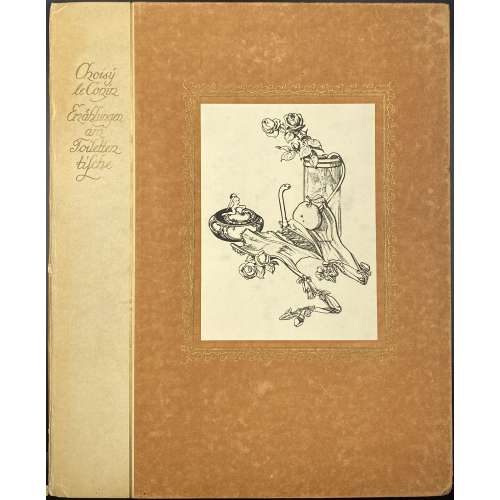 Publisher's flapped portfolio 32.8 x 26.8 cm, gilt-ruled and gilt-lettered quarter faux-parchment waxed paper over brown paper boards with pasted illustration after von Bayros within gilt arabesque frame. Possibly published in Vienna by Heinrich Conrad in 1905 or 1908. The portfolio contains the title page with a vignette and 15 loose wove paper sheets 32 x 26.2 cm of collotype reproductions after drawings by Franz von Bayros. Cover gilt lettering: Choisÿ | le Conin | Erzählungen | am | Toiletten- | tische || Title-page: Erzählungen | am Toilettentische | von | CHOISY LE CONIN | {vignette} || Title-page verso: Inhalt: | 1. Die Tabaksdose | 2. Viola de Gamba | 3. Der Bote | 4. Nicht drängeln, Kinder! | 5. Die blaue Feder | 6. O what a pretty like-place! | 7. Die Sonnenuhr |8. Der Temel der der Cotÿs | 9. Der Fetischist | 10. Jupiter und Europa | 11. Die Witwe | 12. Paroxÿsme-erotique | 13. Der Rivale | 14. Die rote Lehrerin | 15. Tantalus | Nicht im Handel. || Catalogue raisonné: The amorous drawings of the Marquis von Bayros / Part I and II. — NY: Cythera Press, 1968; pp. 95-111 [LIB-2246.2019]
Publisher's flapped portfolio 32.8 x 26.8 cm, gilt-ruled and gilt-lettered quarter faux-parchment waxed paper over brown paper boards with pasted illustration after von Bayros within gilt arabesque frame. Possibly published in Vienna by Heinrich Conrad in 1905 or 1908. The portfolio contains the title page with a vignette and 15 loose wove paper sheets 32 x 26.2 cm of collotype reproductions after drawings by Franz von Bayros. Cover gilt lettering: Choisÿ | le Conin | Erzählungen | am | Toiletten- | tische || Title-page: Erzählungen | am Toilettentische | von | CHOISY LE CONIN | {vignette} || Title-page verso: Inhalt: | 1. Die Tabaksdose | 2. Viola de Gamba | 3. Der Bote | 4. Nicht drängeln, Kinder! | 5. Die blaue Feder | 6. O what a pretty like-place! | 7. Die Sonnenuhr |8. Der Temel der der Cotÿs | 9. Der Fetischist | 10. Jupiter und Europa | 11. Die Witwe | 12. Paroxÿsme-erotique | 13. Der Rivale | 14. Die rote Lehrerin | 15. Tantalus | Nicht im Handel. || Catalogue raisonné: The amorous drawings of the Marquis von Bayros / Part I and II. — NY: Cythera Press, 1968; pp. 95-111 [LIB-2246.2019] -
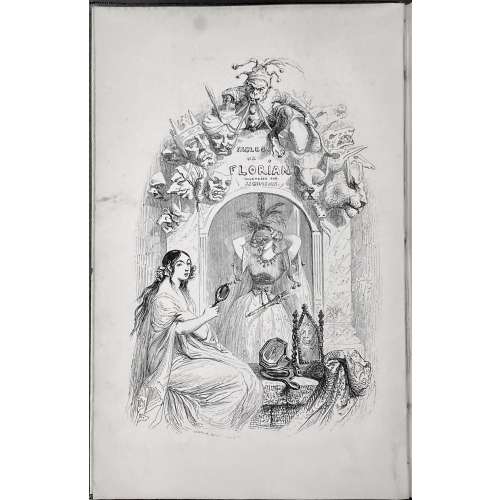 FABLES | DE FLORIAN | ILLUSTRÉES | PAR J.-J. GRANDVILLE , | SUIVIES | DE TOBIE ET RUTH , | Poëmes tirés de l'Ecriture Sainte | ET | PRECEDEES D'UNE NOTICE SUR LA VIE ET LES OUVRAGES DE FLORIAN , | PAR P.-J. STAHL. | [Vignette] PARIS. | J.-J. DUBOCHET ET Cie , ÉDITEURS , | 1842. Pagination: ffl, [2 blanks] [i, ii - ht/imp.] [2 - blank/engr. t.p. by Grandville] [iii, iv - t.p./blank] [v] vi-xx; 2 sheets of plates, [3] 4-292, bfl; engraved t.p. + [79] leaves of plates + 5 faux t.p. (total 85 plates) Size: In-8vo, 23.8 x 15 cm. Binding: Orig. blind-stamped navy cloth with gilt Grandville characters to boards and spine. First edition, first printing. Reference: Léopold Carteret (Le trésor du bibliophile. Epoque romantique. 1801-1875 / Livres illustrés du XIXe siècle. – Paris: L. Carteret; imprim. Lahure, 1927). Wood engravers: Adolphe Best (French, 1808 – 1860): 22 plates Louis-Henri Brévière (French, 1797 – 1869): 3 plates Brugnot (French, active 19th century): 7 plates Prosper-Adolphe-Léon Cherrier (French, born 1806): 6 + Tobie et Ruth + vignettes Louis Dujardin (French, 1808 – 1859): 2 plates Monogram GO–> (possibly for Godard) : 1 plate Halley-Hiback (French, 19th century): 1 + vignette Henri-Désiré Porret (French, 1800–1867): 2 + vignette Lacoste père et fils aîné et Auguste-Alexandre Guillaumot (French, 1815 – 1892): 5 plates Quichon (French, 19th century): 10 plates + Tobie et Ruth François Rouget (Belgian, born bef., 1825): 19 + vignette Unsigned or with an illegible signature: 6 plates
FABLES | DE FLORIAN | ILLUSTRÉES | PAR J.-J. GRANDVILLE , | SUIVIES | DE TOBIE ET RUTH , | Poëmes tirés de l'Ecriture Sainte | ET | PRECEDEES D'UNE NOTICE SUR LA VIE ET LES OUVRAGES DE FLORIAN , | PAR P.-J. STAHL. | [Vignette] PARIS. | J.-J. DUBOCHET ET Cie , ÉDITEURS , | 1842. Pagination: ffl, [2 blanks] [i, ii - ht/imp.] [2 - blank/engr. t.p. by Grandville] [iii, iv - t.p./blank] [v] vi-xx; 2 sheets of plates, [3] 4-292, bfl; engraved t.p. + [79] leaves of plates + 5 faux t.p. (total 85 plates) Size: In-8vo, 23.8 x 15 cm. Binding: Orig. blind-stamped navy cloth with gilt Grandville characters to boards and spine. First edition, first printing. Reference: Léopold Carteret (Le trésor du bibliophile. Epoque romantique. 1801-1875 / Livres illustrés du XIXe siècle. – Paris: L. Carteret; imprim. Lahure, 1927). Wood engravers: Adolphe Best (French, 1808 – 1860): 22 plates Louis-Henri Brévière (French, 1797 – 1869): 3 plates Brugnot (French, active 19th century): 7 plates Prosper-Adolphe-Léon Cherrier (French, born 1806): 6 + Tobie et Ruth + vignettes Louis Dujardin (French, 1808 – 1859): 2 plates Monogram GO–> (possibly for Godard) : 1 plate Halley-Hiback (French, 19th century): 1 + vignette Henri-Désiré Porret (French, 1800–1867): 2 + vignette Lacoste père et fils aîné et Auguste-Alexandre Guillaumot (French, 1815 – 1892): 5 plates Quichon (French, 19th century): 10 plates + Tobie et Ruth François Rouget (Belgian, born bef., 1825): 19 + vignette Unsigned or with an illegible signature: 6 plates -
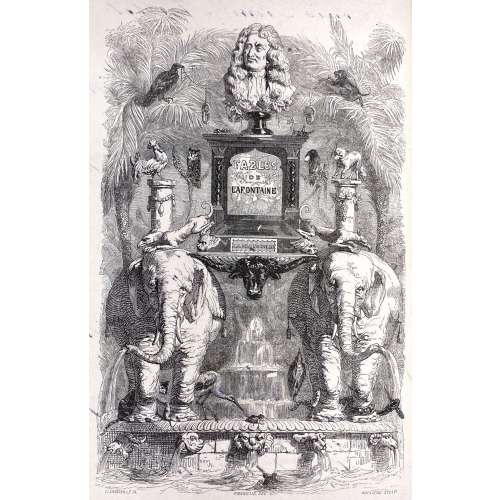 Fables de La Fontaine / édition illustrée par J. J. Grandville (in 2 volumes). – Paris: H. Fournier Ainé, Perronin, 1838. Imp. H. Fournier et Ce, 14 rue de Seine (Premier Tirage). Vol 1: [2 - ht, imprim.] [2 - blank with handwritten inscription, frontis.] [2 - t.p., blank], [ [i] ii-xxviii - épitre, préface, [2 - plate 'fables', [1] 2 - dedication, [3, 4 - pltate: livre 1, blank] [5, 6 - plate: blank, cigale] [7] 8 - fab.1 (the subsequent plates are not paginated) - 292. (245-246 - Avertissement), (247-248 - A mamdam de Montespan); Wood engravings: frontispiece + half-title Fables + 7 running half-titles Livres des Fables + 72 plates. Vol. 2: [2 - ht, imprim.] [2 - t.p., blank] [1, 2 - plate 'livre 8', blank] [3] 4-312 (191-192 épilogue), (195-196 Au duc de Bourgogne), (268 - fin des fables), (269-296 Philemon et Baucis | D. O. M. | La Martone Déphèse | Belphegor), (297 -308 notice), (309-312 table); Wood engravings: 5 running half-titles Livres des Fables + 1 half-title Philemon et Baucis + 48 plates. Size: 8vo, 23.2 x 15 cm. Binding: Full tree-calf, flat spine stamped with gilt, red and brown labels with gilt lettering, marbled endpapers. Handwritten nut ink inscription to blank recto of frontispiece: the history of Millet-Fontaine family (provenance?) There were two print-runs in the year 1838. According to Léopold Carteret (Le trésor du bibliophile. Epoque romantique. 1801-1875 / Livres illustrés du XIXe siècle. – Paris: L. Carteret; imprim. Lahure, 1927, pp. 357-9), the first run (Premier Tirage) published by H. Fournier and Perrotin, while the Second Tirage by H. Fournier Ainé. Though, the initial cap character "N" at p. xiii (vie d'Ésope) in this copy is formed by 'faite de lignes bouclées' as in the first print-run, rather than by 'petits carreaux noirs et blances' as in the second. We can conclude with confidence that this copy belongs to Premier Tirage.
Fables de La Fontaine / édition illustrée par J. J. Grandville (in 2 volumes). – Paris: H. Fournier Ainé, Perronin, 1838. Imp. H. Fournier et Ce, 14 rue de Seine (Premier Tirage). Vol 1: [2 - ht, imprim.] [2 - blank with handwritten inscription, frontis.] [2 - t.p., blank], [ [i] ii-xxviii - épitre, préface, [2 - plate 'fables', [1] 2 - dedication, [3, 4 - pltate: livre 1, blank] [5, 6 - plate: blank, cigale] [7] 8 - fab.1 (the subsequent plates are not paginated) - 292. (245-246 - Avertissement), (247-248 - A mamdam de Montespan); Wood engravings: frontispiece + half-title Fables + 7 running half-titles Livres des Fables + 72 plates. Vol. 2: [2 - ht, imprim.] [2 - t.p., blank] [1, 2 - plate 'livre 8', blank] [3] 4-312 (191-192 épilogue), (195-196 Au duc de Bourgogne), (268 - fin des fables), (269-296 Philemon et Baucis | D. O. M. | La Martone Déphèse | Belphegor), (297 -308 notice), (309-312 table); Wood engravings: 5 running half-titles Livres des Fables + 1 half-title Philemon et Baucis + 48 plates. Size: 8vo, 23.2 x 15 cm. Binding: Full tree-calf, flat spine stamped with gilt, red and brown labels with gilt lettering, marbled endpapers. Handwritten nut ink inscription to blank recto of frontispiece: the history of Millet-Fontaine family (provenance?) There were two print-runs in the year 1838. According to Léopold Carteret (Le trésor du bibliophile. Epoque romantique. 1801-1875 / Livres illustrés du XIXe siècle. – Paris: L. Carteret; imprim. Lahure, 1927, pp. 357-9), the first run (Premier Tirage) published by H. Fournier and Perrotin, while the Second Tirage by H. Fournier Ainé. Though, the initial cap character "N" at p. xiii (vie d'Ésope) in this copy is formed by 'faite de lignes bouclées' as in the first print-run, rather than by 'petits carreaux noirs et blances' as in the second. We can conclude with confidence that this copy belongs to Premier Tirage.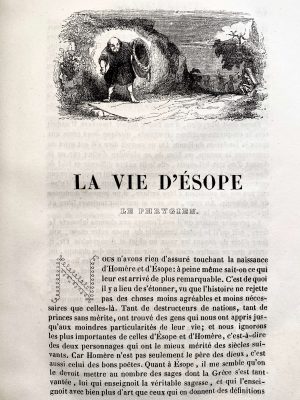 Wood engravings (135 plates, including frontispiece, and numerous headpieces and initial letters) were cut by the following artists (the first number is the number of the chapter ('livre'), the second – the number of the fable within the 'livre':
Wood engravers:
John Bastin, (British, fl. 1840 – 1850): 6-6, 7-13, and 8-9.
Alexandre Belhatte (French, born in 1811): 3-11 and chapter title pages to 'livres' 6, 11, 12, headpices on p. 117 in vol. 2, and 'Philemon et Baucis' section title page.
J. Constantine Beneworth (active France, 19th century): 1-6.
Louis-Henri Brévière (French, 1797 – 1869): 1-10, 2-7, 6-10, 6-21, 7-4, 8-10, 8-27, 9-3, 10-4, 12-11, frontispice, together with François-Louis Français (French, 1814–1897), and 'Fin des fables' tailpiece.
Brévière et Hébert: Louis-Henri Brévière (French, 1797 – 1869) and César-Auguste Hébert (French, active 19th century): 1-1, 1-2, 1-13, 1-18, 2-2, 2-11, 3-1, 3-3, 3-4, 3-18, 4-20, 4-21, 4-22, 5-5, 5-20, 6-2, 6-8, 7-3, 8-7, 8-12, 8-14, 8-17, 9-14, 10-6, 10-16, 11-6, 12-4, 12-25.
Joseph-Hippolyte-Jules Caqué (French, 1814 – 1885): 7-11 and headpieces on p. 251 in vol. 1 and on p. 197 in vol. 2.
Prosper-Adolphe-Léon Cherrier (French, born 1806): 8-6.
Henry Isidore Chevauchet (French, fl. 1837 – 1850): 1-19, 2-4, and 4-5.
Louis Dujardin (French, 1808 – 1859): 10-9.
Pierre-François Godard (French, 1768 – 1838): 1-5, 1-16, 5-2, and 10-11.
Charles David Laing (British, fl. 1836 – 1853): 7-9.
Lacoste père et fils aîné et Auguste-Alexandre Guillaumot (French, 1815 – 1892): 1-4, 1-20, 9-17, and 11-5.
Laisné (Alfred, Adèle, and Aglaé) (French, active 1835–1868): 5-8, 6-5, 6-17, 8-2, 8-15, 9-9, 9-10, 11-1, 11-8, 12-10.
(Alfred, Adèle, and Aglaé) Laisné (French, active 1835–1868): 5-8, 6-5, 6-17, 8-2, 8-15, 9-9, 9-10, 11-1, 11-8, 12-10.
Théodore Maurisset (French, fl. 1834 – 1859): 2-14 and 6-13.
Antoine-Alphée Piaud (French, 1813 – 1867): 1-17, 2-9, 2-16, 4-1, 4-4, 5-15, 5-17, 5-18, 5-21, 8-22, 8-23, 8-25, 9-19, 10-13, 11-3, 11-9, 12-13, 12-15, 12-21, three 'livres': 3, 9, 10, and headpiece on p. 71 in vol. 2.
Roux-Jourdain: Two 'livre' title pages, 1 and 2.
John Orrin Smith (British, 1799 – 1843): 2-13, 2-18, 3-9, 3-14, 4-9, and 4-14.L. Chauchefoin (French): 2-3 and 5.13.
Matthew Urlwin Sears (British, 1799 – 1870): 10-1 and 12-9.
Monogram TM or MT (possibly for Théodore Maurisset): 6-16 and 10-3.
Monogram GO–> (possibly for Godard) : 5-3, 7-1, and 9-5.
Monogram B and BV: 4-11, 12-6, 'livre' 4, and headpieces on p. 1 in vol. 1 and on p. 167 in vol. 2.
Unsigned or with an illegible signature: "fables' section title, 1-3, 1-9, 3-5, 3-8, 4-15, 4-18, 5-10, 7-7, 7-16, 9-2, 9-4, 12-2, 12-3, 12-17, and two 'livre' title pages, 5 and 8.
Little is know about Matthew Urlwin Sears. He was a wood engraver of good reputation who is known to have worked in London in the early 1820s, Paris and Leipzig. Listed as "wood engraver" on records of the UK Printing Historical Society. Work The British Museum owns three of his earliest published works, engravings for Northcote's Fables (1828). He authored "Specimen of stereotype ornaments, 1825" which was reprinted as a facsimile in 1990 by the Printing Historical Society (London), with a foreword by James Mosley. He is mentioned by Pierre Gusman in "La Gravure sur Bois en France" (Paris, 1929). Laurent's Histoire de l'Empereur Napoleon, (1839) is one of many publications on which both Sears and his partner John Quartly worked, as well as numerous other engravers. His work appeared in "Aunt Effie's Rhymes" (1852) and "Uncle Tom's Cabin", by Harriet Beech Stowe (Edinburgh: Adam and Charles Black, 1853) [Claire-Juliette Beale, December 2009].
Wood engravings (135 plates, including frontispiece, and numerous headpieces and initial letters) were cut by the following artists (the first number is the number of the chapter ('livre'), the second – the number of the fable within the 'livre':
Wood engravers:
John Bastin, (British, fl. 1840 – 1850): 6-6, 7-13, and 8-9.
Alexandre Belhatte (French, born in 1811): 3-11 and chapter title pages to 'livres' 6, 11, 12, headpices on p. 117 in vol. 2, and 'Philemon et Baucis' section title page.
J. Constantine Beneworth (active France, 19th century): 1-6.
Louis-Henri Brévière (French, 1797 – 1869): 1-10, 2-7, 6-10, 6-21, 7-4, 8-10, 8-27, 9-3, 10-4, 12-11, frontispice, together with François-Louis Français (French, 1814–1897), and 'Fin des fables' tailpiece.
Brévière et Hébert: Louis-Henri Brévière (French, 1797 – 1869) and César-Auguste Hébert (French, active 19th century): 1-1, 1-2, 1-13, 1-18, 2-2, 2-11, 3-1, 3-3, 3-4, 3-18, 4-20, 4-21, 4-22, 5-5, 5-20, 6-2, 6-8, 7-3, 8-7, 8-12, 8-14, 8-17, 9-14, 10-6, 10-16, 11-6, 12-4, 12-25.
Joseph-Hippolyte-Jules Caqué (French, 1814 – 1885): 7-11 and headpieces on p. 251 in vol. 1 and on p. 197 in vol. 2.
Prosper-Adolphe-Léon Cherrier (French, born 1806): 8-6.
Henry Isidore Chevauchet (French, fl. 1837 – 1850): 1-19, 2-4, and 4-5.
Louis Dujardin (French, 1808 – 1859): 10-9.
Pierre-François Godard (French, 1768 – 1838): 1-5, 1-16, 5-2, and 10-11.
Charles David Laing (British, fl. 1836 – 1853): 7-9.
Lacoste père et fils aîné et Auguste-Alexandre Guillaumot (French, 1815 – 1892): 1-4, 1-20, 9-17, and 11-5.
Laisné (Alfred, Adèle, and Aglaé) (French, active 1835–1868): 5-8, 6-5, 6-17, 8-2, 8-15, 9-9, 9-10, 11-1, 11-8, 12-10.
(Alfred, Adèle, and Aglaé) Laisné (French, active 1835–1868): 5-8, 6-5, 6-17, 8-2, 8-15, 9-9, 9-10, 11-1, 11-8, 12-10.
Théodore Maurisset (French, fl. 1834 – 1859): 2-14 and 6-13.
Antoine-Alphée Piaud (French, 1813 – 1867): 1-17, 2-9, 2-16, 4-1, 4-4, 5-15, 5-17, 5-18, 5-21, 8-22, 8-23, 8-25, 9-19, 10-13, 11-3, 11-9, 12-13, 12-15, 12-21, three 'livres': 3, 9, 10, and headpiece on p. 71 in vol. 2.
Roux-Jourdain: Two 'livre' title pages, 1 and 2.
John Orrin Smith (British, 1799 – 1843): 2-13, 2-18, 3-9, 3-14, 4-9, and 4-14.L. Chauchefoin (French): 2-3 and 5.13.
Matthew Urlwin Sears (British, 1799 – 1870): 10-1 and 12-9.
Monogram TM or MT (possibly for Théodore Maurisset): 6-16 and 10-3.
Monogram GO–> (possibly for Godard) : 5-3, 7-1, and 9-5.
Monogram B and BV: 4-11, 12-6, 'livre' 4, and headpieces on p. 1 in vol. 1 and on p. 167 in vol. 2.
Unsigned or with an illegible signature: "fables' section title, 1-3, 1-9, 3-5, 3-8, 4-15, 4-18, 5-10, 7-7, 7-16, 9-2, 9-4, 12-2, 12-3, 12-17, and two 'livre' title pages, 5 and 8.
Little is know about Matthew Urlwin Sears. He was a wood engraver of good reputation who is known to have worked in London in the early 1820s, Paris and Leipzig. Listed as "wood engraver" on records of the UK Printing Historical Society. Work The British Museum owns three of his earliest published works, engravings for Northcote's Fables (1828). He authored "Specimen of stereotype ornaments, 1825" which was reprinted as a facsimile in 1990 by the Printing Historical Society (London), with a foreword by James Mosley. He is mentioned by Pierre Gusman in "La Gravure sur Bois en France" (Paris, 1929). Laurent's Histoire de l'Empereur Napoleon, (1839) is one of many publications on which both Sears and his partner John Quartly worked, as well as numerous other engravers. His work appeared in "Aunt Effie's Rhymes" (1852) and "Uncle Tom's Cabin", by Harriet Beech Stowe (Edinburgh: Adam and Charles Black, 1853) [Claire-Juliette Beale, December 2009]. -
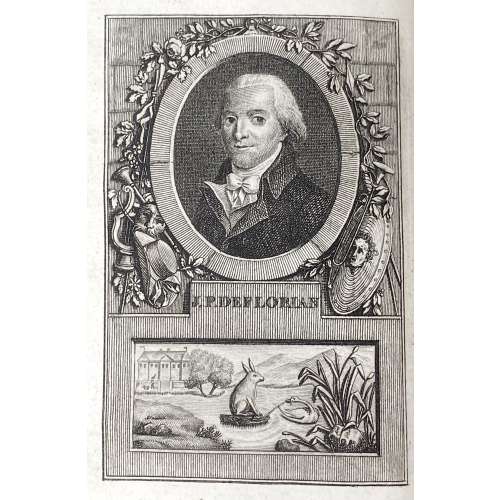 Title: FABLES | DE | M. DE FLORIAN , | de l’académie françoise, de celles de Madrid , | Florence, etc. | — | Je tâche d'y tourner le vice ridicule , | Ne pouvant l'attaquer avec des bras d'Hercule. | La Font. Fables , liv. V , I. — | [publisher's device ] | A PARIS, | DE L'IMPRIMERIE DE P. DIDOT L'AINÉ, | 1792. Pagination: ffl, [2 - h.t. / Imp.] [2 - blank / frontis.] [2 - tp. / blank] [5] 6-224 [2 - advert. / blank], bfl. Collation: numbered 1(5), 2-18(6), 19(3); engarved frontispiece portrait of Florian after François Hüet-Villiers, 5 engraved plates by Longueil, Delignon, and Gaucher after Flouest. Binding: Contemporary full mottled calf, all margins red, gilt floral ornaments to flat spine, red label with gilt lettering. Catalogue raisonné: Cohen, de Ricci 1912: p. 398-9.
Title: FABLES | DE | M. DE FLORIAN , | de l’académie françoise, de celles de Madrid , | Florence, etc. | — | Je tâche d'y tourner le vice ridicule , | Ne pouvant l'attaquer avec des bras d'Hercule. | La Font. Fables , liv. V , I. — | [publisher's device ] | A PARIS, | DE L'IMPRIMERIE DE P. DIDOT L'AINÉ, | 1792. Pagination: ffl, [2 - h.t. / Imp.] [2 - blank / frontis.] [2 - tp. / blank] [5] 6-224 [2 - advert. / blank], bfl. Collation: numbered 1(5), 2-18(6), 19(3); engarved frontispiece portrait of Florian after François Hüet-Villiers, 5 engraved plates by Longueil, Delignon, and Gaucher after Flouest. Binding: Contemporary full mottled calf, all margins red, gilt floral ornaments to flat spine, red label with gilt lettering. Catalogue raisonné: Cohen, de Ricci 1912: p. 398-9. -
 Hand-coloured woodcut on wove paper, 400 x 270 mm; black ink stamp “5306” to reverse. Top centre: "FAMILLE IMPÉRIALE", right: "62."; below centre: "Fabrique d'Images de GANGEL et P. DIDION, à Metz."; right: "Déposé." Publisher/printer: Gangel et P. Didion (Metz); Paulin Didion (French, 1831 – 1879). Characters: Napoleon III [Charles-Louis Napoléon Bonaparte] (French, 1808 – 1873) Eugénie de Montijo [L'impératrice Eugénie] (Spanish-French, 1826 – 1920) Napoléon, Prince Imperial (Napoléon Eugène Louis Jean Joseph Bonaparte] (French, 1856 – 1879) Napoléon II [Napoléon François Joseph Charles Bonaparte] (French, 1811 – 1832) Napoléon Ier [Napoléon Bonaparte] (French, 1769 – 1821)
Hand-coloured woodcut on wove paper, 400 x 270 mm; black ink stamp “5306” to reverse. Top centre: "FAMILLE IMPÉRIALE", right: "62."; below centre: "Fabrique d'Images de GANGEL et P. DIDION, à Metz."; right: "Déposé." Publisher/printer: Gangel et P. Didion (Metz); Paulin Didion (French, 1831 – 1879). Characters: Napoleon III [Charles-Louis Napoléon Bonaparte] (French, 1808 – 1873) Eugénie de Montijo [L'impératrice Eugénie] (Spanish-French, 1826 – 1920) Napoléon, Prince Imperial (Napoléon Eugène Louis Jean Joseph Bonaparte] (French, 1856 – 1879) Napoléon II [Napoléon François Joseph Charles Bonaparte] (French, 1811 – 1832) Napoléon Ier [Napoléon Bonaparte] (French, 1769 – 1821) -
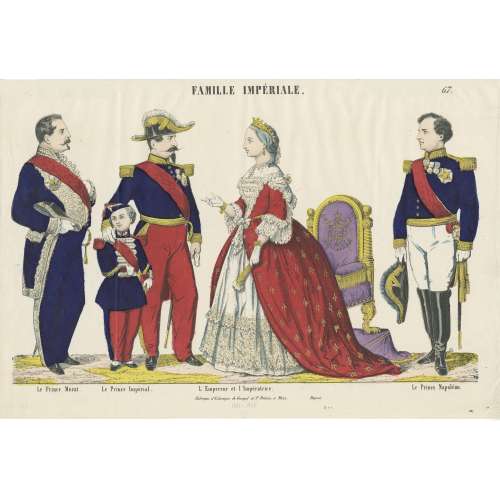 Hand-coloured woodcut on wove paper, 288 x 426 mm; black ink stamp “5305” to reverse. Top centre: "FAMILLE IMPÉRIALE", right: "67." Under the image: "Le Prince Murat." — "Le Prince Impérial." — "L' Empereur et l'Impératrice." — "Le Prince Napoléon." Bottom: "Fabrique d'Estampes de Gangel et P. Didion, à Metz." — "Déposé." Bottom: ms in pencil "1861 – 1868". Publisher/printer: Gangel et P. Didion (Metz); Paulin Didion (French, 1831 – 1879). Characters: Napoleon III [Charles-Louis Napoléon Bonaparte] (French, 1808 – 1873) Eugénie de Montijo [L'impératrice Eugénie] (Spanish-French, 1826 – 1920) Napoléon, Prince Imperial (Napoléon Eugène Louis Jean Joseph Bonaparte] (French, 1856 – 1879) Prince Murat [Lucien Charles Joseph Napoléon] (French, 1803 – 1878) Napoléon-Jérôme Bonaparte [Prince Napoléon] (French, 1822 – 1891)
Hand-coloured woodcut on wove paper, 288 x 426 mm; black ink stamp “5305” to reverse. Top centre: "FAMILLE IMPÉRIALE", right: "67." Under the image: "Le Prince Murat." — "Le Prince Impérial." — "L' Empereur et l'Impératrice." — "Le Prince Napoléon." Bottom: "Fabrique d'Estampes de Gangel et P. Didion, à Metz." — "Déposé." Bottom: ms in pencil "1861 – 1868". Publisher/printer: Gangel et P. Didion (Metz); Paulin Didion (French, 1831 – 1879). Characters: Napoleon III [Charles-Louis Napoléon Bonaparte] (French, 1808 – 1873) Eugénie de Montijo [L'impératrice Eugénie] (Spanish-French, 1826 – 1920) Napoléon, Prince Imperial (Napoléon Eugène Louis Jean Joseph Bonaparte] (French, 1856 – 1879) Prince Murat [Lucien Charles Joseph Napoléon] (French, 1803 – 1878) Napoléon-Jérôme Bonaparte [Prince Napoléon] (French, 1822 – 1891) -
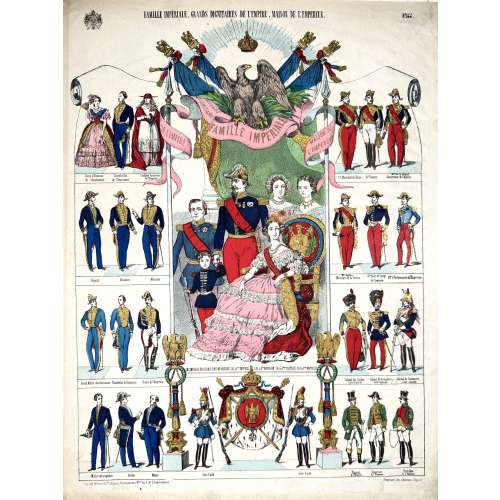 Hand-coloured woodcut on wove paper, 487 x 365 mm; black ink stamp “5056” to reverse. Top left: imperial coat of arms; centre: "FAMILLE IMPERIALE. GRANDS DIGNITAIRES DE L'EMPIRE, MAISON DE L'EMPEREUR."; right: "№144." Image of the imperial family under imperial eagle and standards; besides – four tiers of captioned cartoons. Bottom left: "Imprimerie Lith. de Pellerin, à Épinal"; right: "Propriété de l’Éditeur. — Déposé." Jean Charles Pellerin (French, 1756 – 1836) – printer/publisher.
Hand-coloured woodcut on wove paper, 487 x 365 mm; black ink stamp “5056” to reverse. Top left: imperial coat of arms; centre: "FAMILLE IMPERIALE. GRANDS DIGNITAIRES DE L'EMPIRE, MAISON DE L'EMPEREUR."; right: "№144." Image of the imperial family under imperial eagle and standards; besides – four tiers of captioned cartoons. Bottom left: "Imprimerie Lith. de Pellerin, à Épinal"; right: "Propriété de l’Éditeur. — Déposé." Jean Charles Pellerin (French, 1756 – 1836) – printer/publisher. -
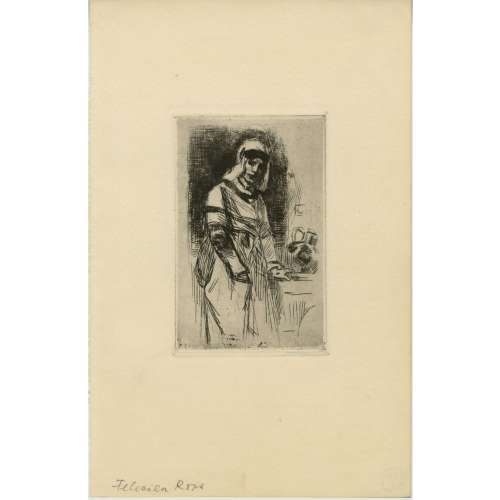
A woman from Antwerp or a servant, another title "Laitière anversoise"; 2nd state. Etching on wove paper. Owner's stamp LVM on verso.
Dimensions: Paper: 24.4 x 15.8 cm; Image: 12 x 7.5 cm
Catalogue raisonné: Arthur Hubschmid (1977): 343.
-
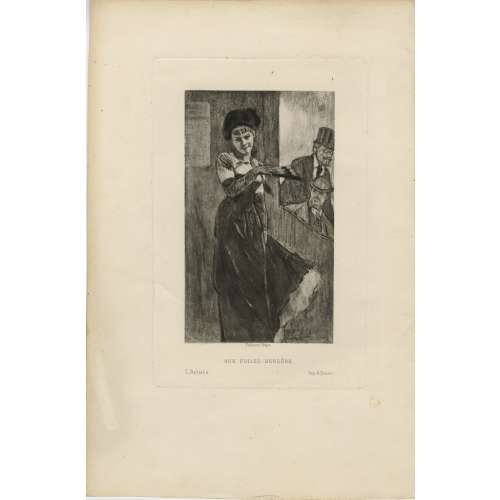
Aquatint finished by a drypoint on wove paper; printed by R. Taneur, depicting young woman in bar Folies Bergère in Paris. Signed in plate under image: "Félicien Rops | AUX FOLIES-BERGÈRE | L'Artiste. — Imp. R. Taneur. Owner's stamp 'LvM' on verso.
Dimensions: Paper: 26.7 x 17.6 cm; Plate: 17.5 x 11.5 cm; Image: 13.5 x 8 cm.
Catalogue raisonné: Graphics irreverent and erotic (1968): 125.


